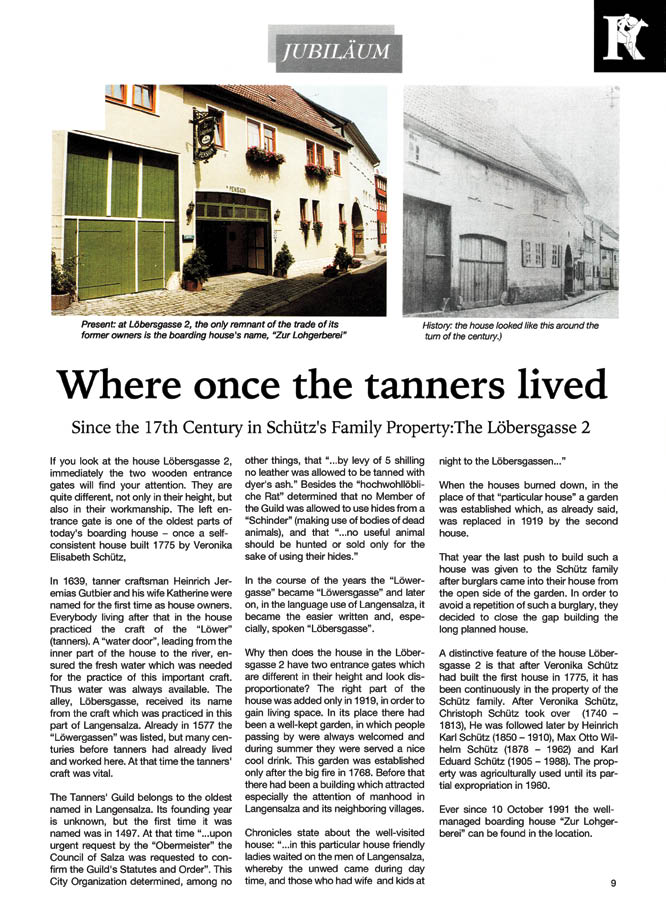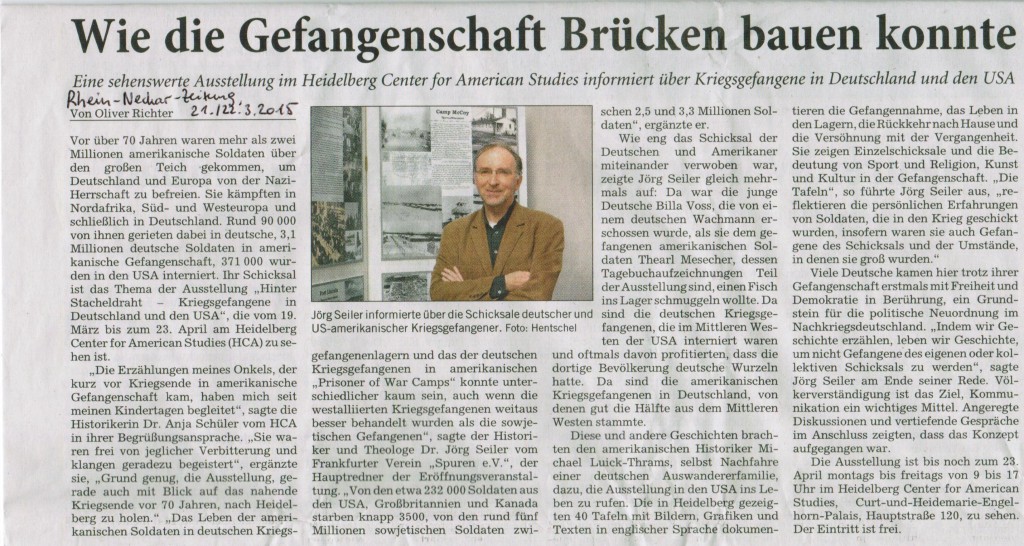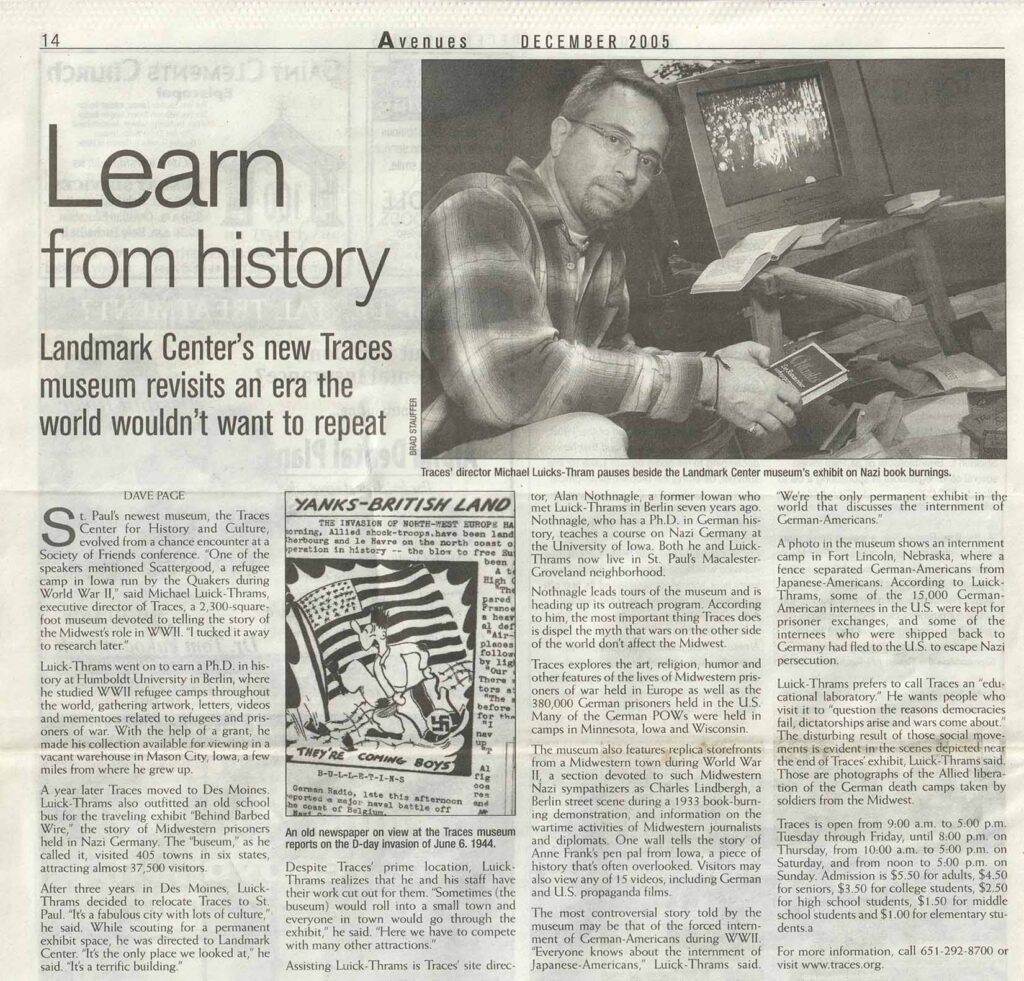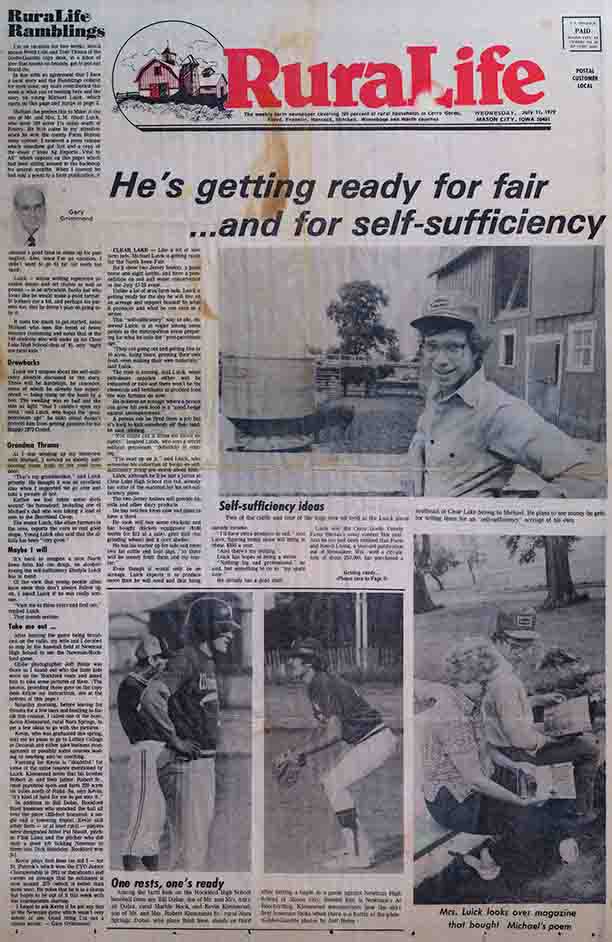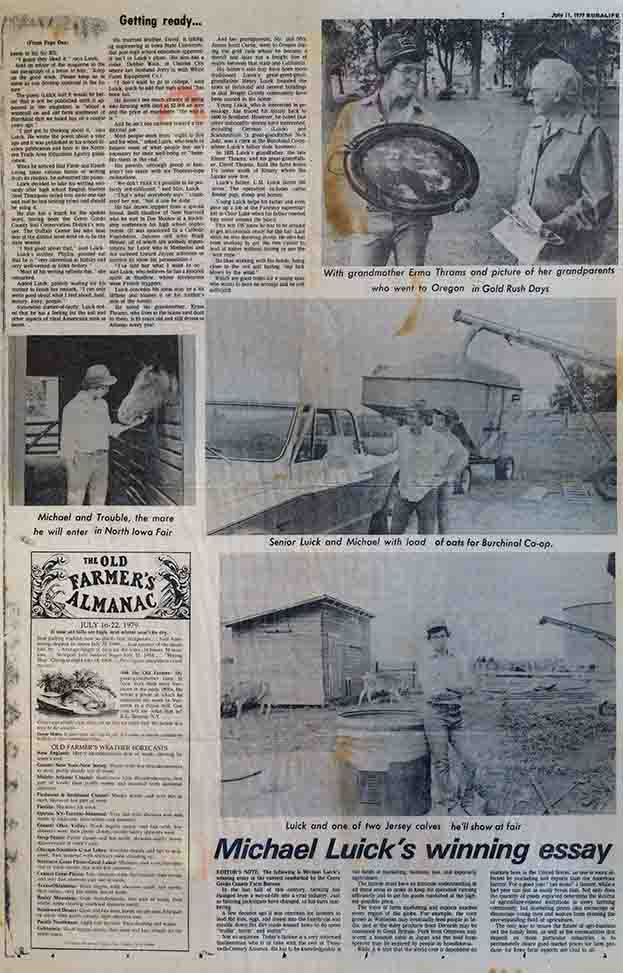22 July 2024
On 22 July 2024, Michael Luick-Thrams, director of TRACES and Haus der Spuren, and Grace Knapp, a fellow American volunteer, were interviewed about their opinions on Presidential candidate Joe Biden’s resignation. The subsequent footage was aired as Germany-wide national news featurettes both midday and that evening. We were pleased to share our perspectives on this involved topic.
4 December 2023
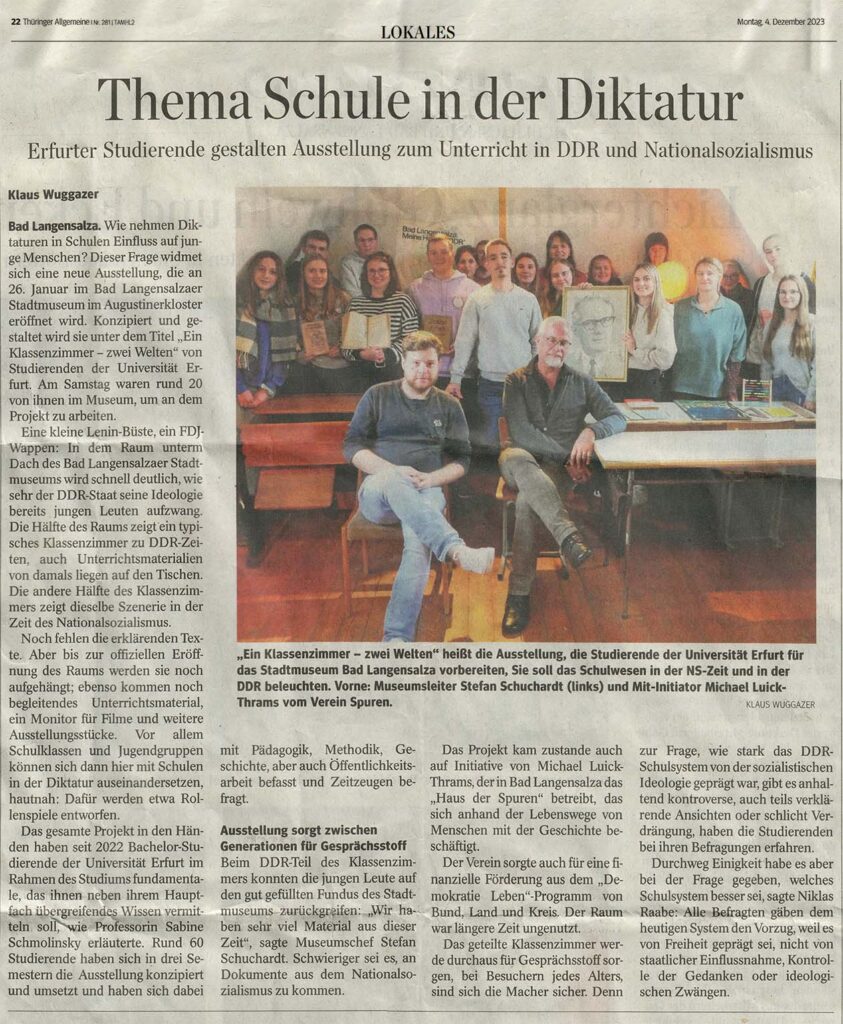
photo: “A classroom – two worlds” is the name of the exhibition which is being prepared by students of the Erfurt University for the Stadtmuseum Bad Langensalza. It is supposed to enlighten the school systems during the National Socialism and in the GDR.
In front: Stefan Schuchardt (left), Head of the Museum, and the Co-Initiator, Michael Luick-Thrams of the Society “Haus der Spuren”.
Thüringer Allgemeine, No. 28 – Local News Monday, 4th December 2023
“SCHOOL SYSTEMS DURING DICTATORSHIPS”
Students in Erfurt organize an exhibition about school systems during the GDR and National Socialism
Klaus Wuggazer
Bad Langensalza. How do dictatorships influence young people in schools? This problem is addressed by the next exhibition which will open its doors on 26 January at the Stadtmuseum in the Augustiner Cloister in Bad Langensalza. Students of the Erfurt University will conceive and organize it under the title “One Classroom – Two Worlds”. Last Saturday about 20 students were at the museum to work on the project.
A small Lenin bust, a coat of arms of the FDJ (Translator’ remark: Freie Deutsche Jugend): in the room under the roof of the museum in Bad Langensalza it soon becomes apparent how much the GDR was able to impose its ideology on young people. Half of the room shows a typical classroom during GDR times. The teaching material of the time is lying on the tables. The other half of the room shows the same setting during National Socialism.
Explaining texts are still missing, however, they will be there in time for the official opening of the exhibition, as well as accompanying teaching material, a monitor to show films, and further exhibits. Especially classes and youth groups will then be able to closely learn about school systems during dictatorships. For this, role-playing is being conceptualized.
Professor Sabine Schmolinsky explains that since 2022 the whole project has been in the hands of Bachelor students of the Erfurt University within the scope of the “Studium fundamentale”. Besides their main subjects, this offers the students overall knowledge. In 3 semesters, about 60 students have conceived and realized the exhibition, they have dealt with pedagogy, methodology, public relations and have interviewed contemporary witnesses.
The exhibition will offer topics of conversation
For the GDR part of the classroom, young people had access to a good-filled fund of the Stadtmuseum. Stefan Schuchard, head of the Museum says: we have a lot of material from that time. Much more difficult is to find documents of the time of National Socialism. The project materialized also through the initiative of Michael Luick-Thrams, who runs the “Haus der Spuren” in Bad Langensalza, which is engaged in discovering people’s history by dealing with the paths of their lives.
Through Society financial sponsorship by the program “Living Democracy” was possible, which is supported by the German Confederation, the Federal State, and the Administrative District. The room had been unused for a long time.
The makers are sure that the divided classroom will offer a lot of topics of conversation for persons of all ages. There is an ongoing controversy as to how intensely the GDR school system had been embossed by the socialist ideology. During their surveys, the students met romanticized opinions and even suppression.
A throughout consent was given as to which system was the better one, said Niklas Raabe: all persons asked preferred today’s system since it is stamped by freedom and not by a State’s influence, control of thoughts, or ideological pressures.
Translated from German by Karin Schramm.
5 november 2023

Special Exhibition in the “Haus der Spuren”
“I’m doing fine!”
Quite deliberately, historian and chairman of “Spuren”, Michael Luick-Thrams, has decided to use the date 9th November for the opening of the new special exhibition in “Haus der Spuren”, showing personal belongings of soldiers of the German Armed Forces. During many epochs, German history has been lastingly embossed by this date…
34 years ago the Berlin Wall fell on 9 November; in the year 1938 Nazis raged in the “Night of Broken Glasses”; 15 years before that, the Hitler coup failed and, finally, this date is also connected to the November Revolution in 1918 and with the failure of the March Revolution in the year 1848.
(Picture by Eva Maria Wiegand: manually decorated canteens belonging to German soldiers at the front)
For many years the Society “Spuren” in Bad Langensalza has researched the history of the region and, especially, of the people standing behind it. Using personal memorabilia and written stories, members and volunteers of “Spuren” form a picture of the eventful 20th Century in Thuringia and elsewhere. In charge is Michael Luick-Thrams, an American whose ancestors were from Thuringia and emigrated hundreds of years ago. In 1993 he came to Germany to teach at different universities, first to the Humboldt University in Berlin, then to Dresden, Ostrava, and Erfurt. Already in 2001 he founded the US Society “Traces”, whose German branch “Spuren” has existed since 2011 and is domiciled in Bad Langensalza, Unterm Berge 24. The Society is very active and productive: in the course of the last three years, it has employed 60 young people from all over the world. They all have contributed to an intensive refurbishment of history. On professional boards “Haus der Spuren” displays scientifically compiled testimonials of history in Langensalza, Thuringia as well as in the US.
German-American relations are Luick-Thrams’ main line of action, and the time of World War II and Nazi Dictatorship are its defining features. The fates of Colored Germans, German Jews as well as that of American Prisoners of War here, and German POWs in the US are the permanent exhibition’s central themes. Beginning next Thursday it will be complemented by the special exhibition ”Cooking utensils – I’m doing fine!” The exhibition shows items on loan from Andreas Frank of Langensalza, such as individually decorated cooking utensils, belt locks, and similar accessories of German soldiers collected by him in flea markets, household clearances, or by newspaper advertisements.
(Picture by Eva Maria Wiegand: Michael Luick-Thrams, historian and founder of the Society “Spuren”, who operates in Bad Langensalza the “Haus der Spuren”)
For the first time, Michael Luick-Thrams narrates the history of the Satellite Concentration Camp in Berga, near Gera, where Nazis held American prisoners of war like slaves, suffering under inhuman conditions and working for them. This was in gross contradiction to the Geneva Convention. The American historian with a German passport always repeats that, when researching it’s never about military history, but always about the antiwar effect and the question of what happens to people during barbarian times. There is no lack of issues in his research. Every Thursday interested people meet in the house for the “Global Salon”, in order to discuss different issues about German-American or other international relations and occurrences.
(Picture by Eva Maria Wiegand: Unterm Berge 24 houses formidable exhibits and fascinating stories)
“Spuren” does not only talk and research about displacement, escape, and migration, but also acts and helps in practical ways. Thus, since the outbreak of the Ukrainian war, already 48 refugees have been accommodated and taken care of in a house in the city. Nine of them are still in Bad Langensalza. Next Thursday, 9 November at 19:00 hours, the “Haus der Spuren” will be opened for a small festivity, and everybody interested is cordially invited.
Olaf Schulze
(Several pictures are included after this text)
Translated from German by Karin Schramm.
2 november 2023
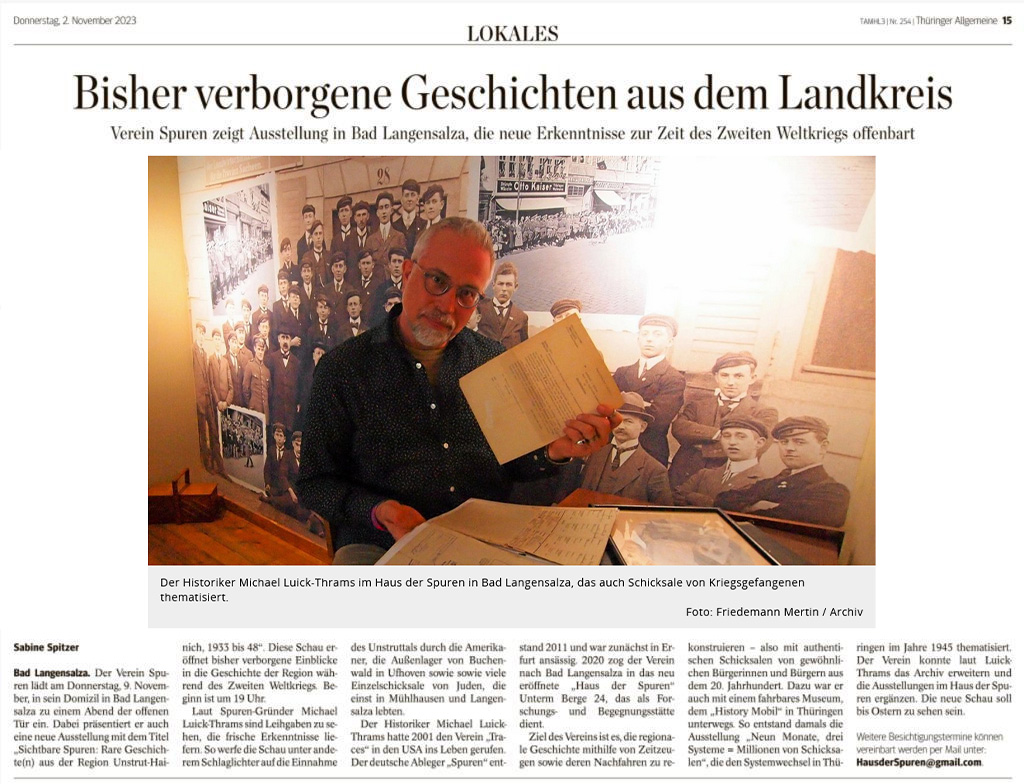
THÜRINGER ALLGEMEINE
Tuesday, 2 November 2023 LOCAL NEWS
HIDDEN STORIES FROM OUR COUNTY
The Society “Spuren” shows exhibition in Bad Langensalza,
revealing new insights into World War II
Sabine Spitzer
Bad Langensalza. The Society “Spuren” invites on Thursday 9 November to an Open House Evening in its residence in Bad Langensalza. They will show a new exhibition with the title “Visible Traces: Rare Stories from the Region Unstrut-Hainichen, 1933 to 1948”. The exhibition provides an insight into hidden stories of the region during World War II, which were until now unknown. Start will be at 19 hours.
According to “Spuren” founder Michael Luick-Thrams, items on loan can be seen which bring new insights. The exhibition highlights the taking over of the Unstrut valley and the satellite camps of Buchenwald by the Americans, and it also shows individual fates of Jews who once lived in Mühlhausen and Langensalza.
In 2001 “Traces” was founded in the US by historian Michael Luick-Thrams. The German section “Spuren” came into being in 2011, at the beginnning in Erfurt. 2020 the Society opened the “Haus der Spuren” in Bad Langensalza, Unterm Berge 24. It serves as a place for research and meeting.
The Society’s goal is to reconstruct local history with the help of contemporary witnesses and their descendants – also recounting authentic fates of citizens in the 20th century. For this Luick-Thrams was also in the move with the “History Mobil” in Thüringen. At that time the exhibition “Nine months, three systems = millions of fates” came into being, broaching the issue of the change of systems in Thüringen in 1945. According to Luick-Thrams the Society was able to enlarge the archive and complement the exhibitions in the “Haus der Spuren”. The new exhibition will be shown until next Easter.
Further appointments to view the exhibition
can be made by mail to:
HausderSpuren@gmail.com
4 October 2023
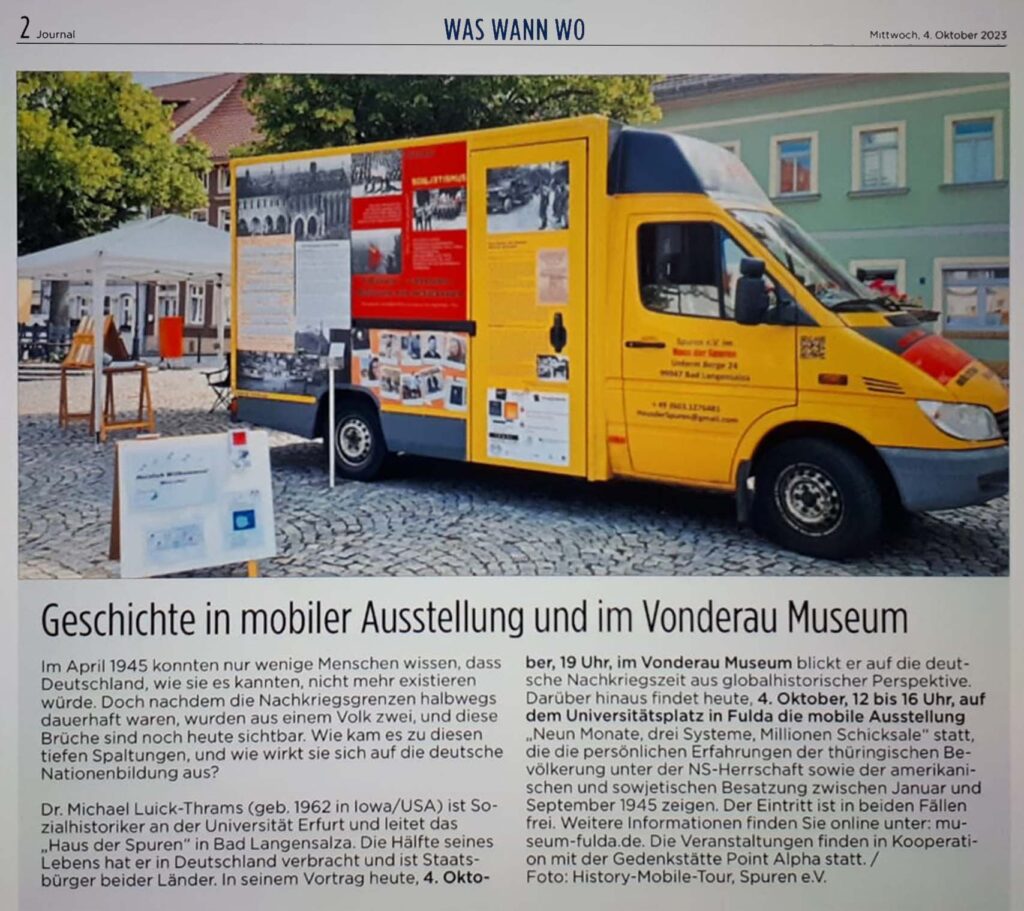
“Man kann nicht nicht politisch kommunizieren”
Die Erinnerung wachhalten: Unterwegs mit dem “rollenden Geschichtsmuseum”
Mobile Ausstellung in Fulda – Kriegsende in Erinnerung rufen
20 July 2023
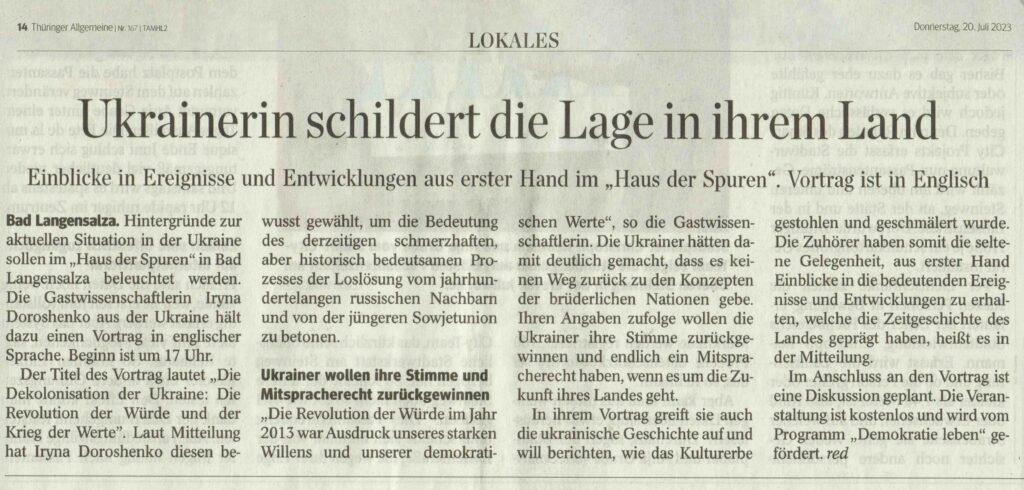
3 July 2023

30 March 2023
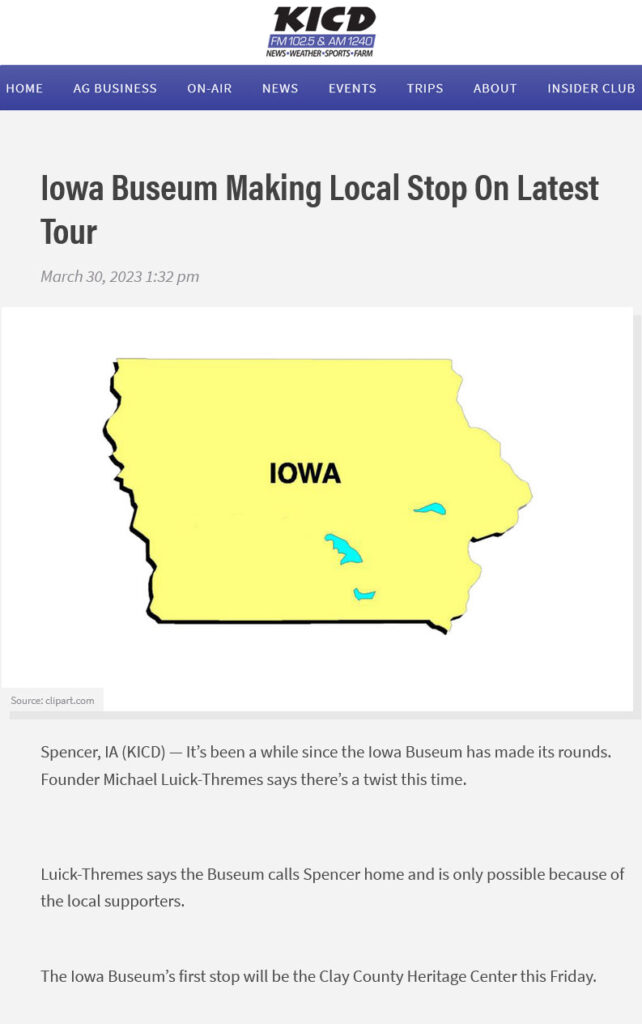
6 January 2023
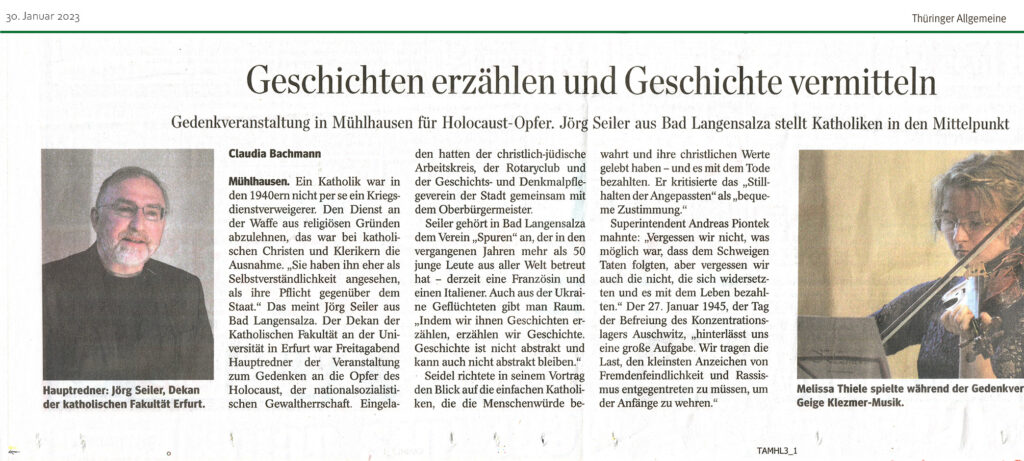
right: During the ceremony Melissa Thiele played Klezmer Music on her violin
COMMUNICATING HISTORY
BY TELLING STORIES
COMMEMORATION CEREMONY IN MÜHLHAUSEN FOR VICTIMS OF THE HOLOCAUST.
JÖRG SEILER FROM BAD LANGESALZA FOCUSSES ON CATHOLICS
Mühlhausen. In the 1940es a Roman Catholic would not necessarily be a conscientious objector (conchie). It was an exception for Catholic Christians and Clergymen to object to military service due to religious reasons. Jörg Seiler from Bad Langensalza opines, “They rather saw that they had to fulfill their obligation”. On Friday evening the Dean of the Catholic University Erfurt was the Main Speaker during the Commemoration Ceremoy for the Victims of the Holocaust, of the Nazi Tyranny. The Ceremony was hosted by the Christian-Jewish Working Committee, the Rotary Club and the Historic Preservation Society together with the Lord Mayor of the city.
In Bad Langensalza Seiler is member of the Association “Spuren” which in the last years has coached more than 50 young people from all over the world – presently a young French lady and a young man from Italy. They have also given space to Ukrainian refugees. “By telling stories we communicate history. History is not abstract and may not remain abstract.”
During his talk Seiler focussed on simple Catholic persons who preserved the human dignity and lived their Christian values – and paid with their deaths. He criticized the “silence of the adapted” as being a “convenient consent”.
Superintendent Andreas Piontek urged: “Let’s not forget that it was possible that deeds followed the silence, but also don’t let us forget those who defied them and had to pay for it with their lives”. 27th January 1945, the day of the liberation of the Contration Camp in Auschwitz, has left us a huge duty: we have to carry the burden to confront the smallest sign of hostility toward strangers and racism in order to nip things in the bud.
6 December 2022
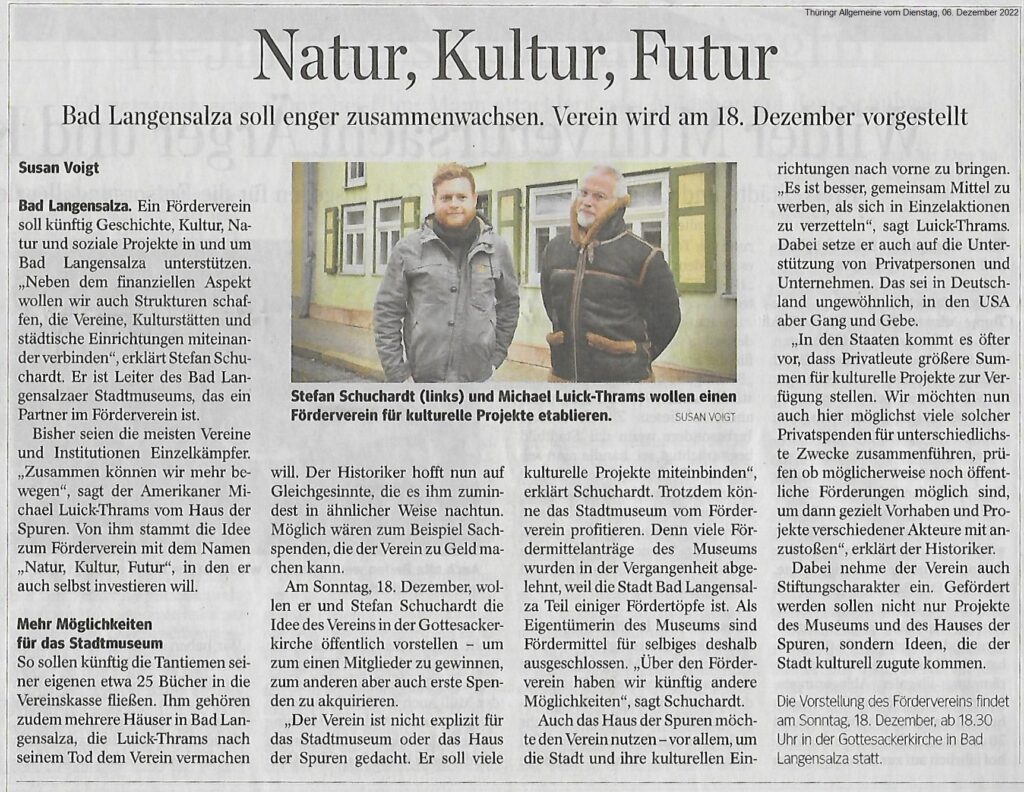
15 November 2022
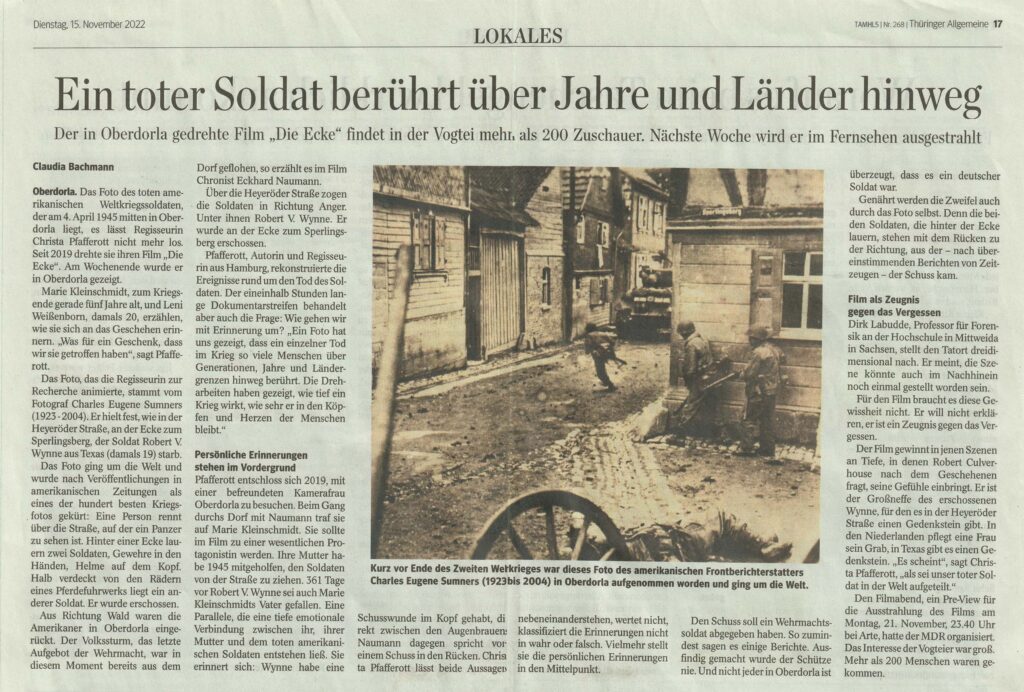
21 August 2022
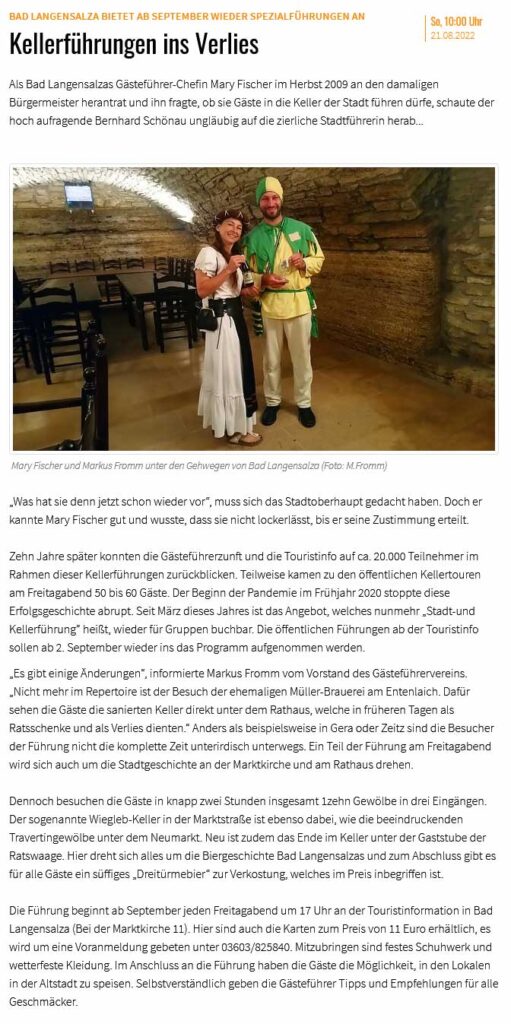
13 August 2022
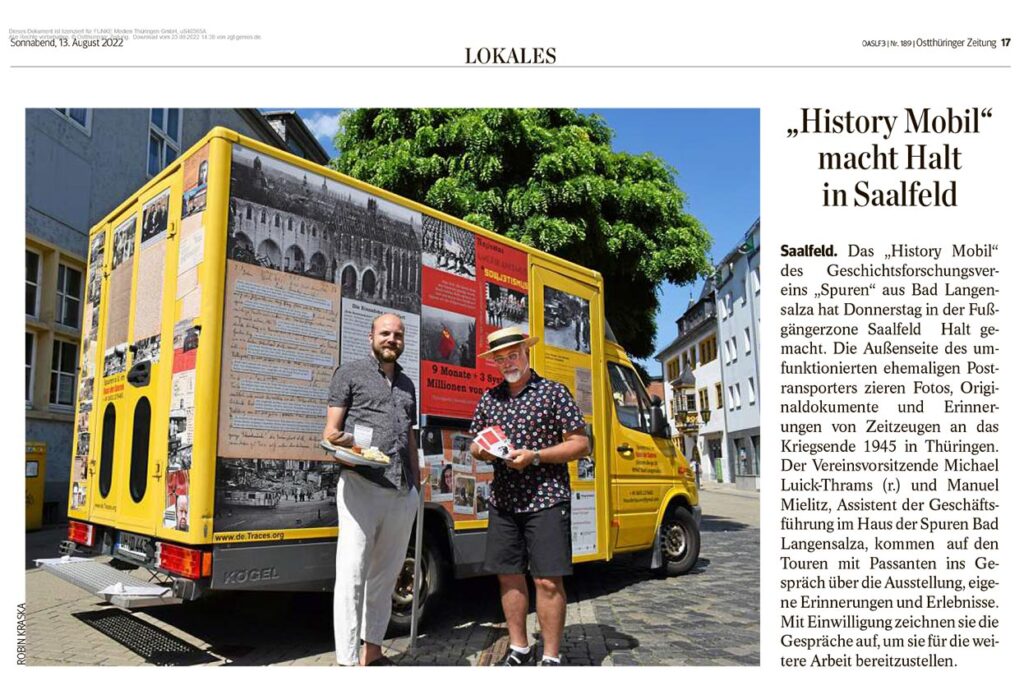
12 August 2022

9 August 2022
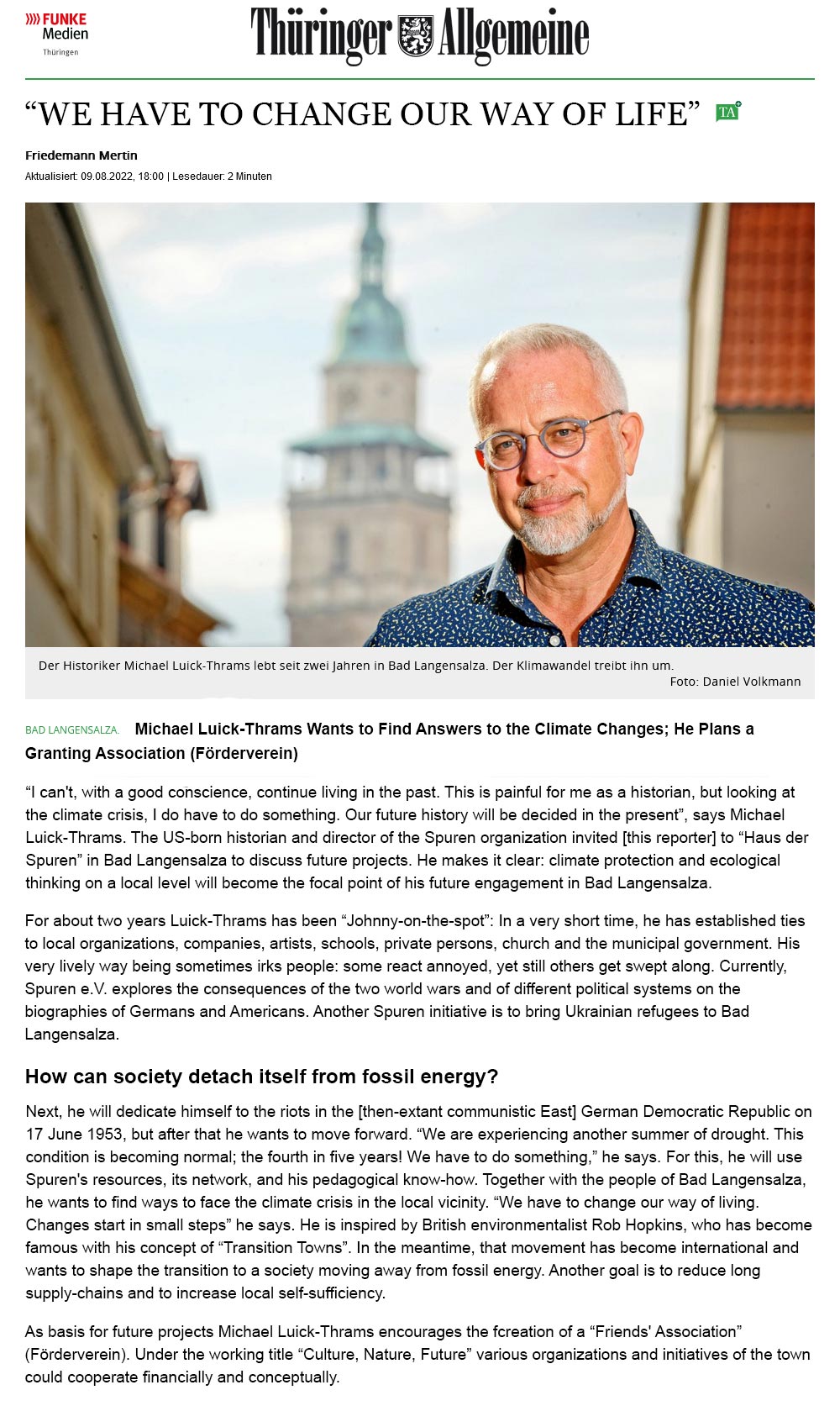
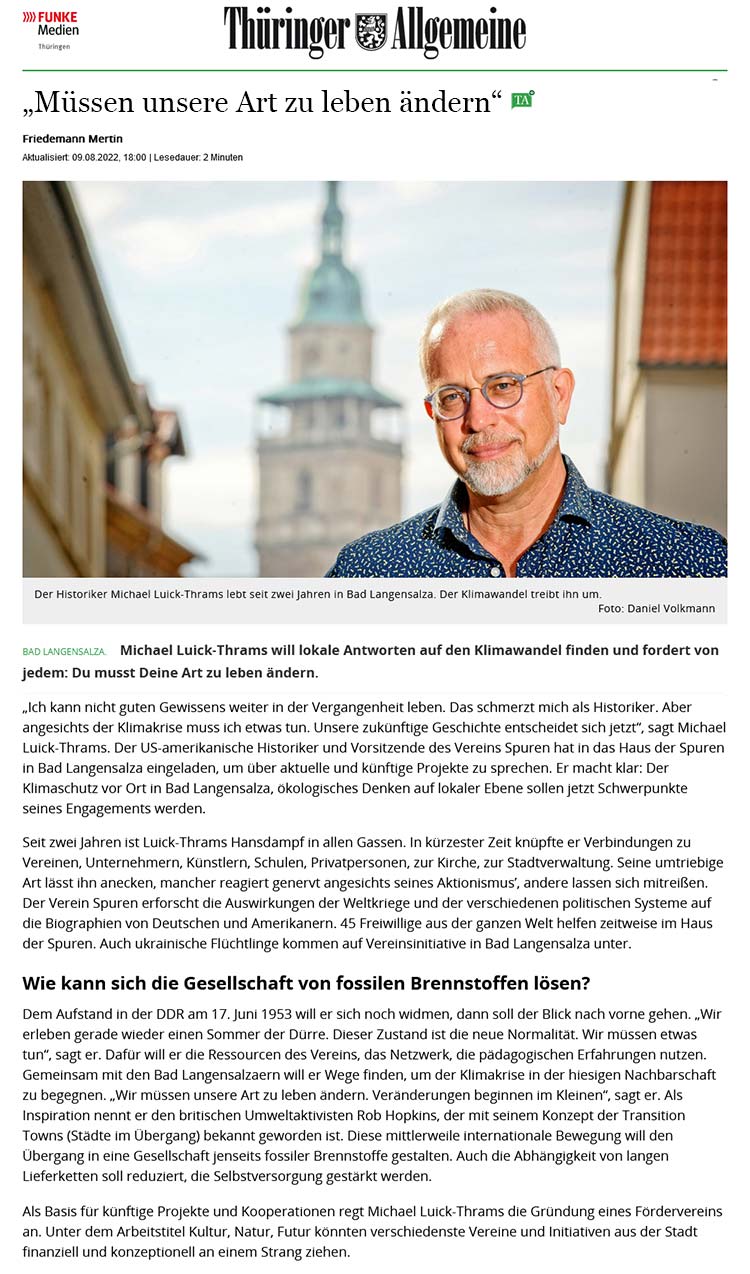
8 August 2022
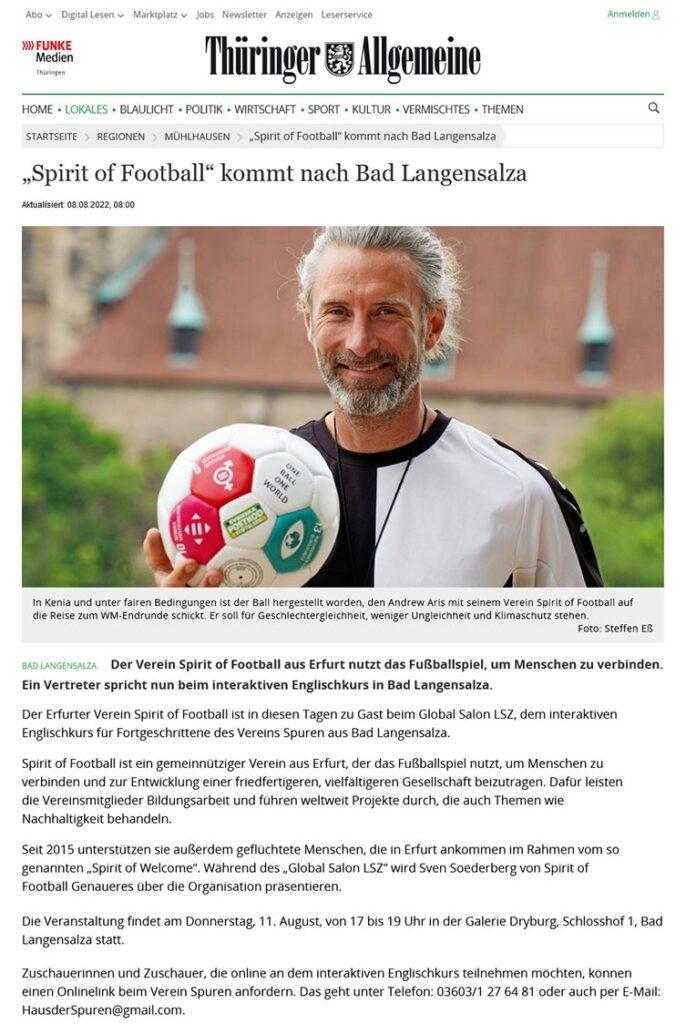
2 August 2022
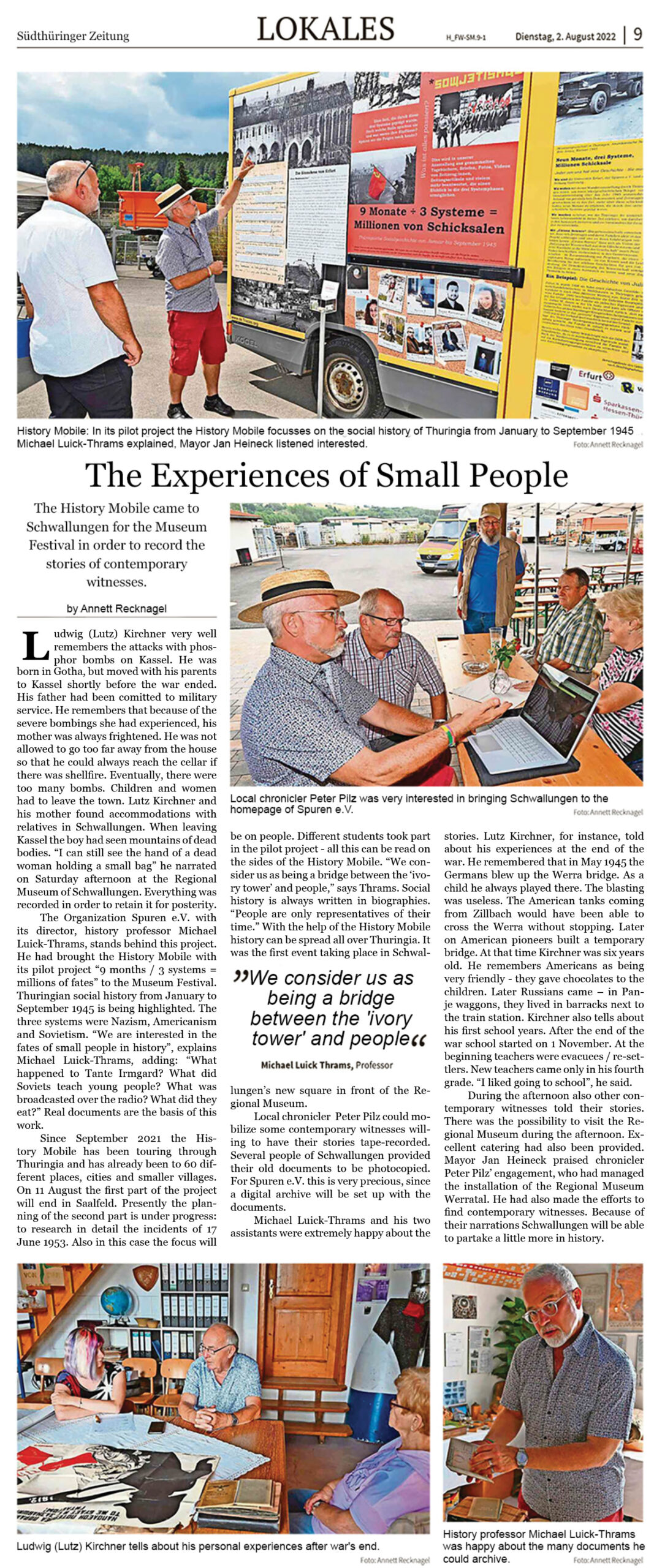

8 July 2022
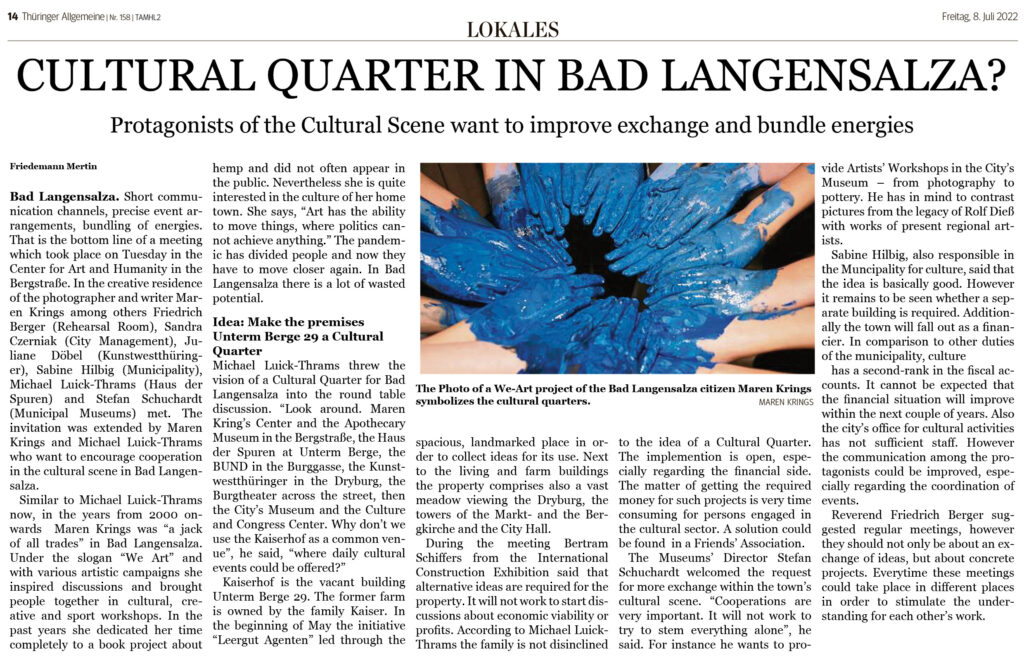

7 July 2022
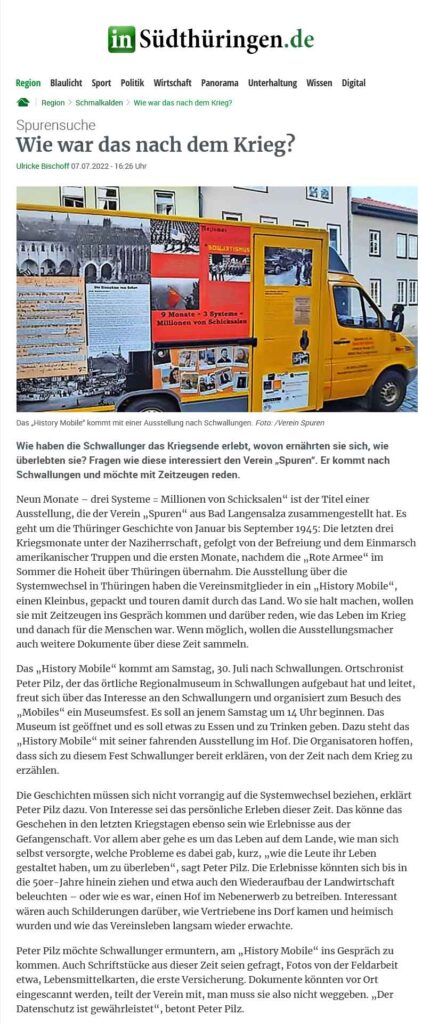
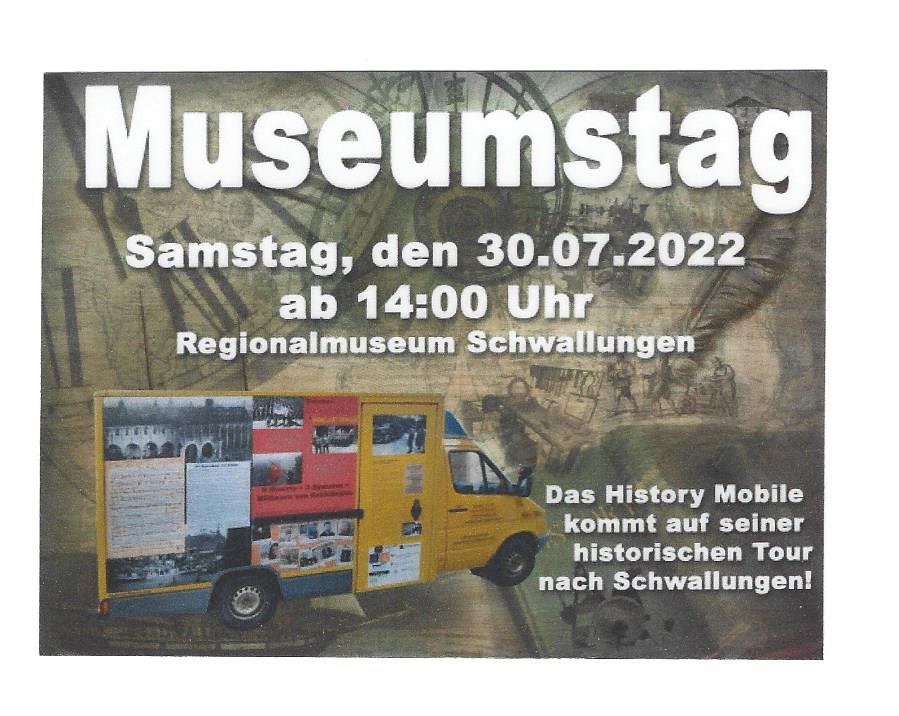
5 July 2022
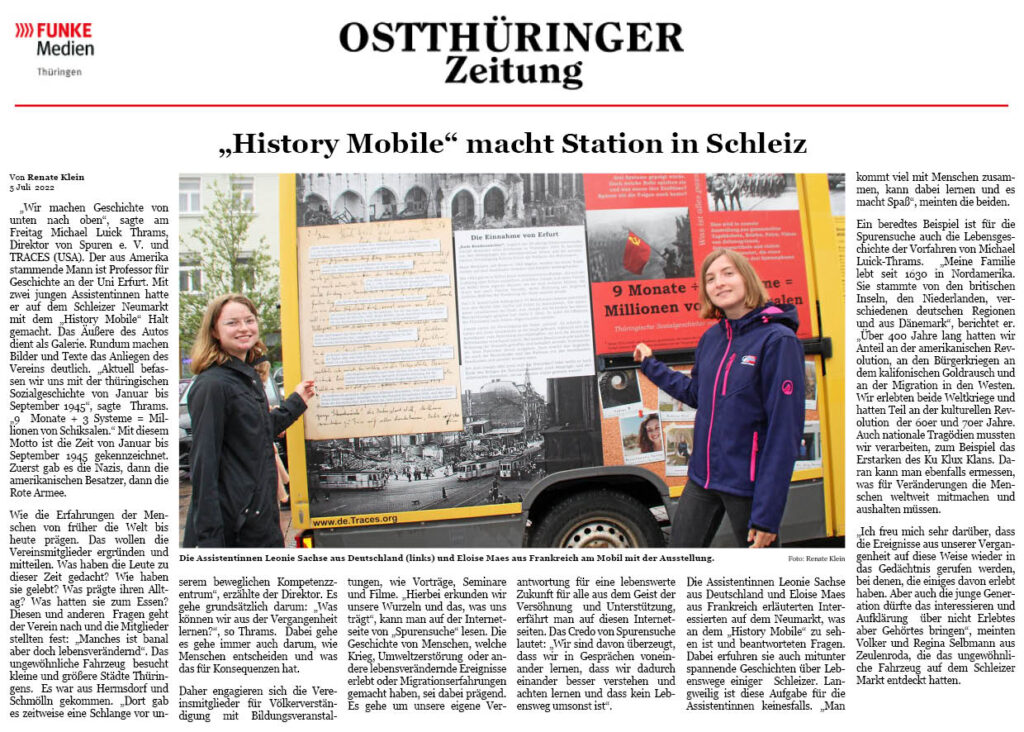
16 June 2022
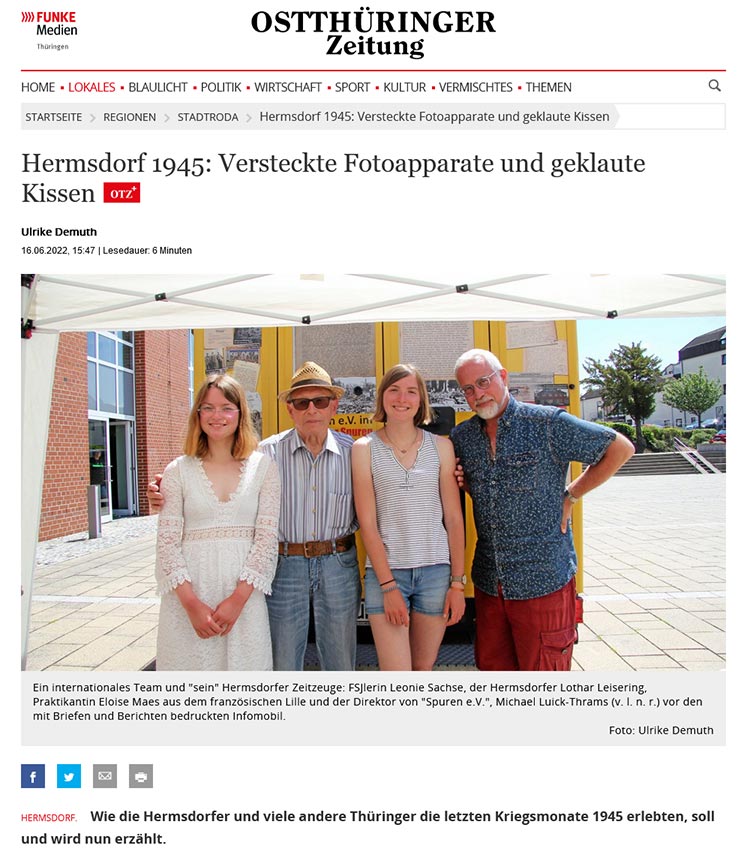
11 May 2022
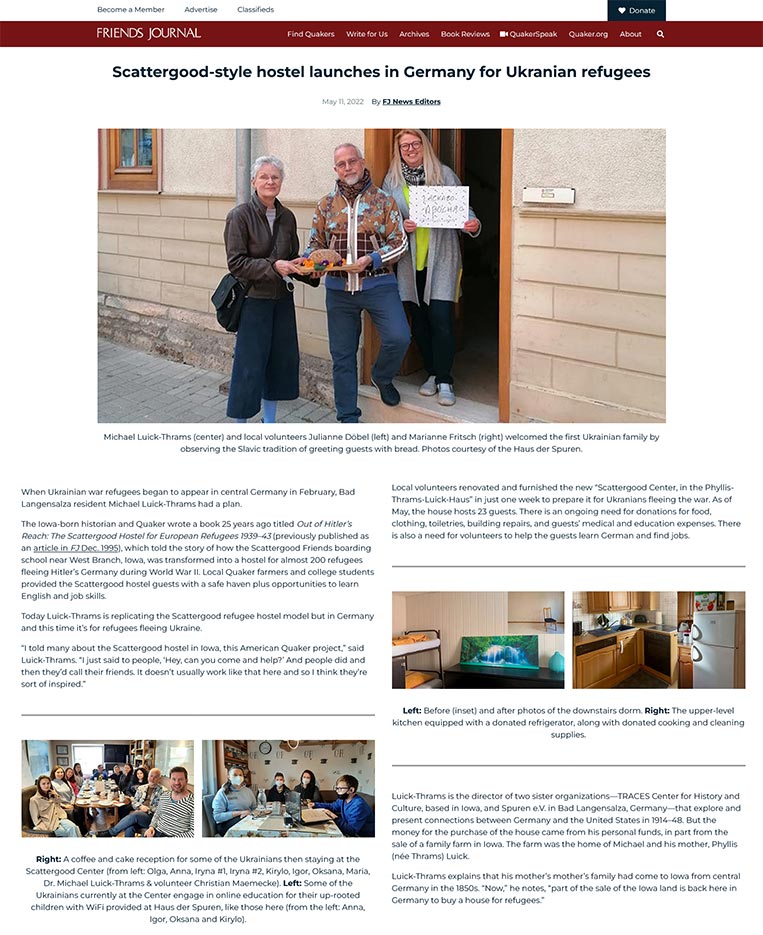
4 May 2022
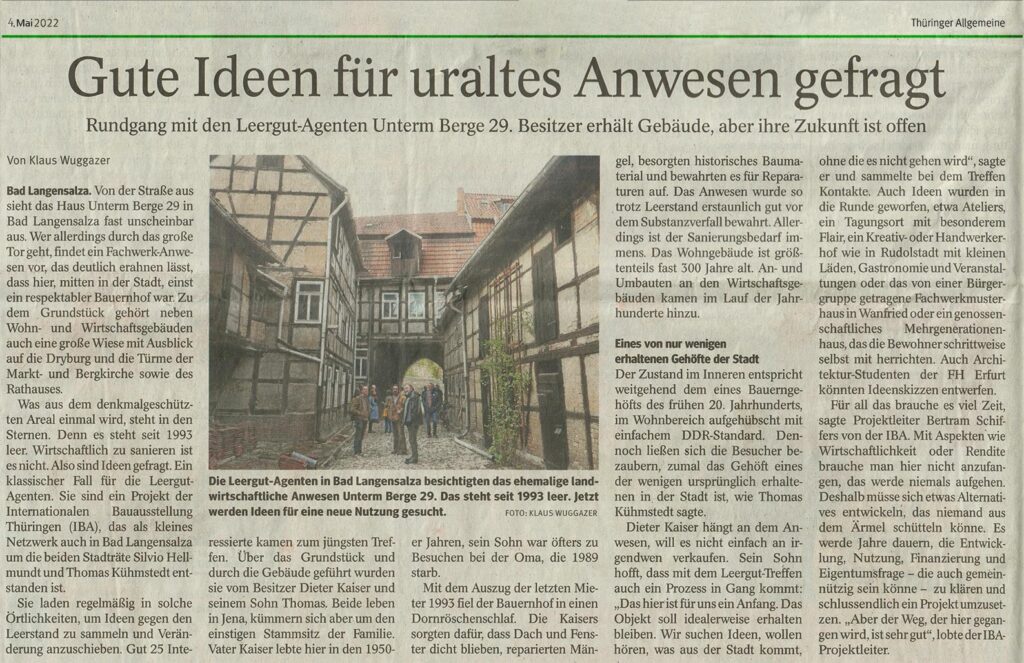
3 May 2022
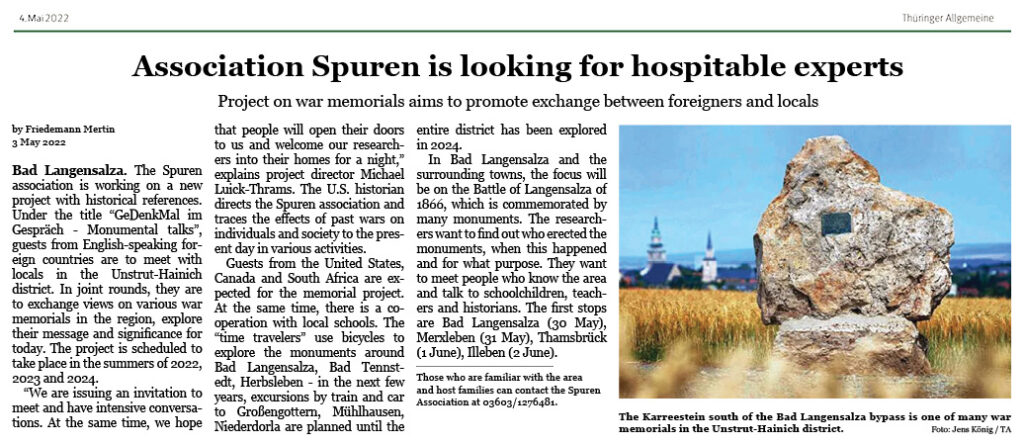
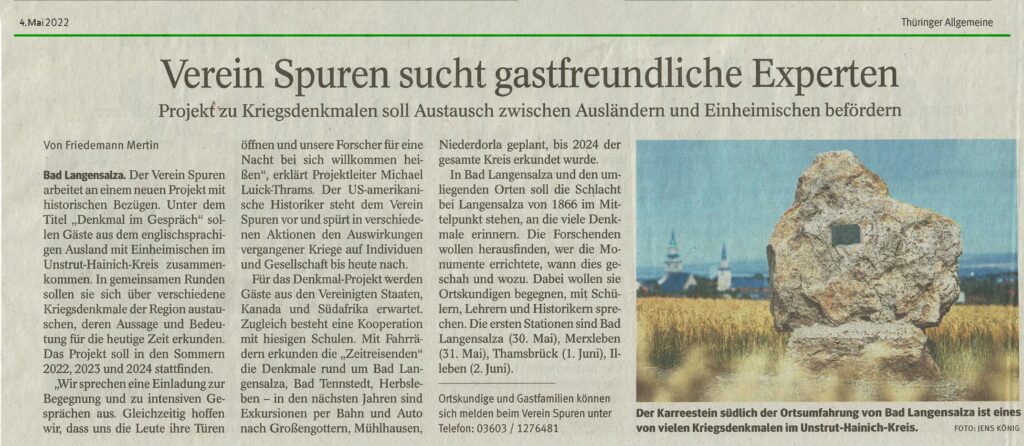
19 April 2022
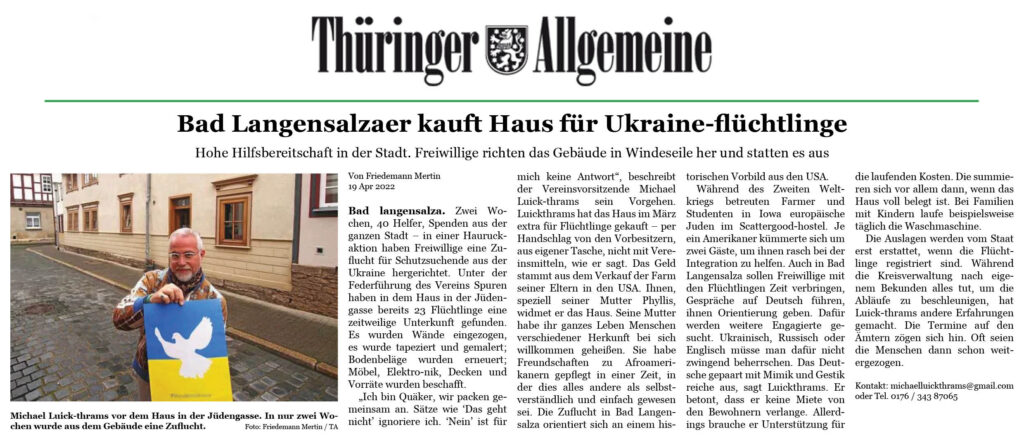

13 April 2022

31 March 2022
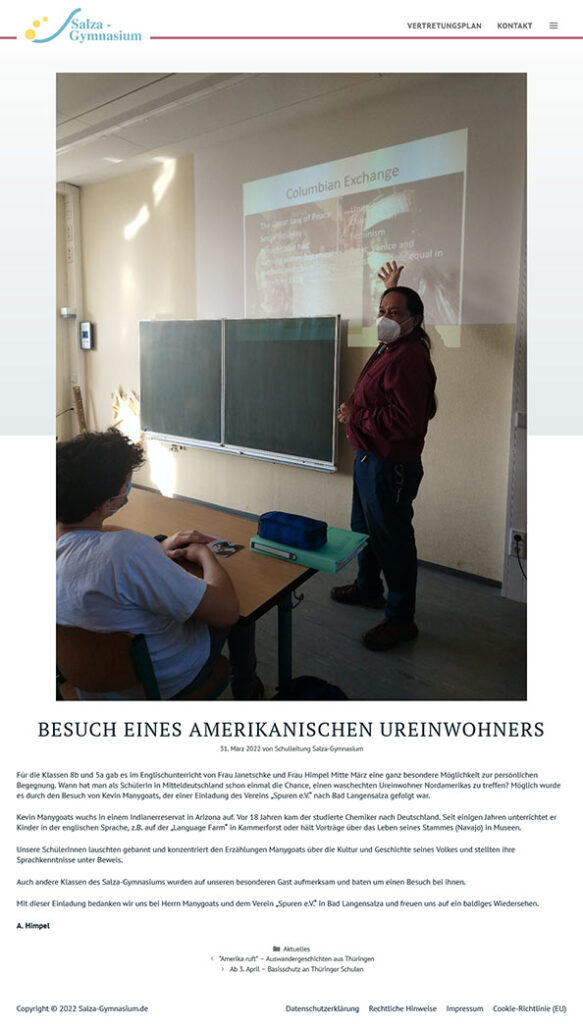
5 March 2022
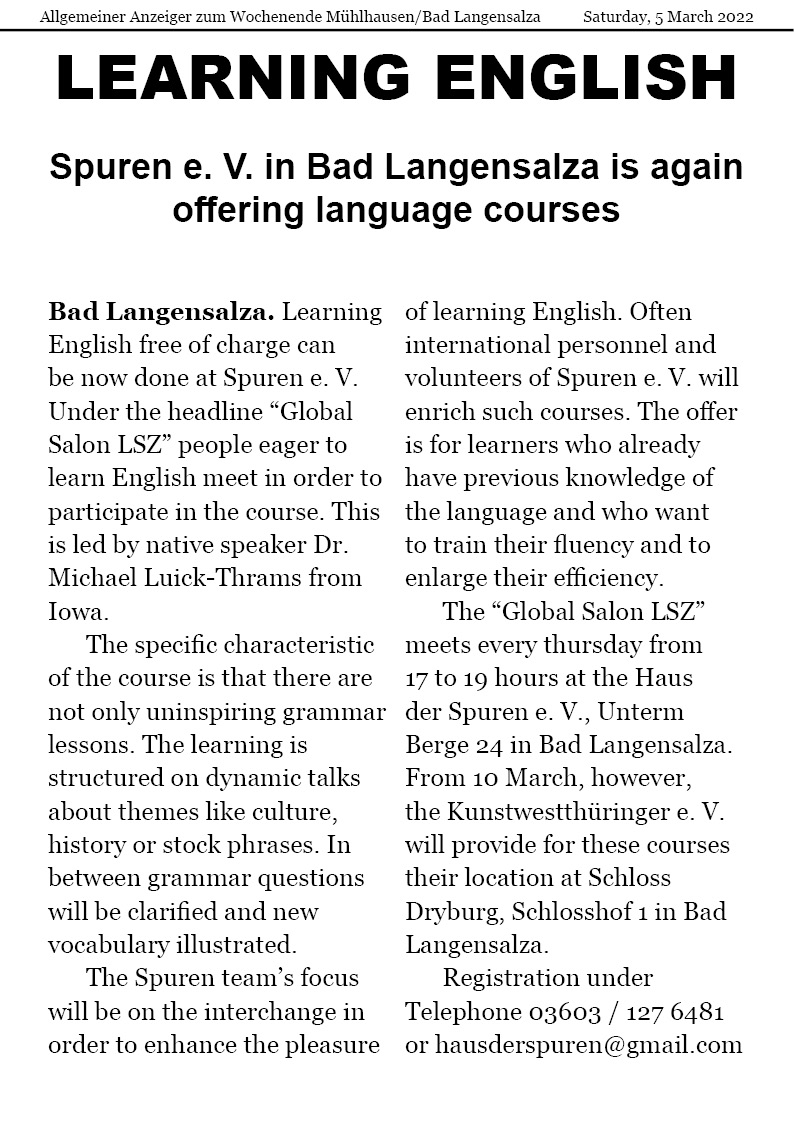

4 March 2022

12 February 2022
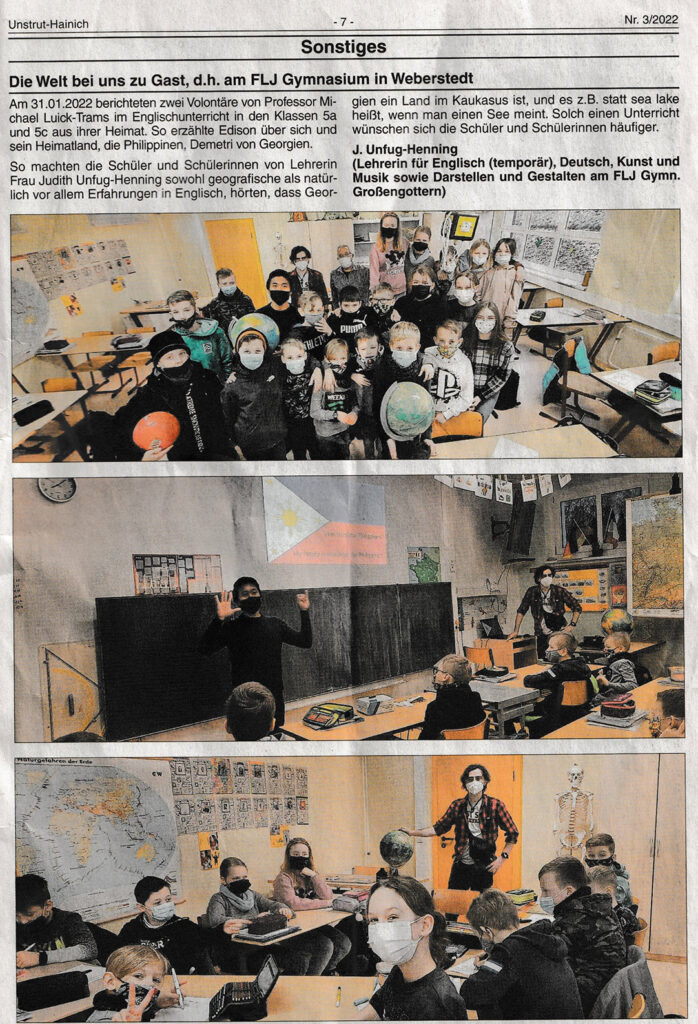
12 February 2022

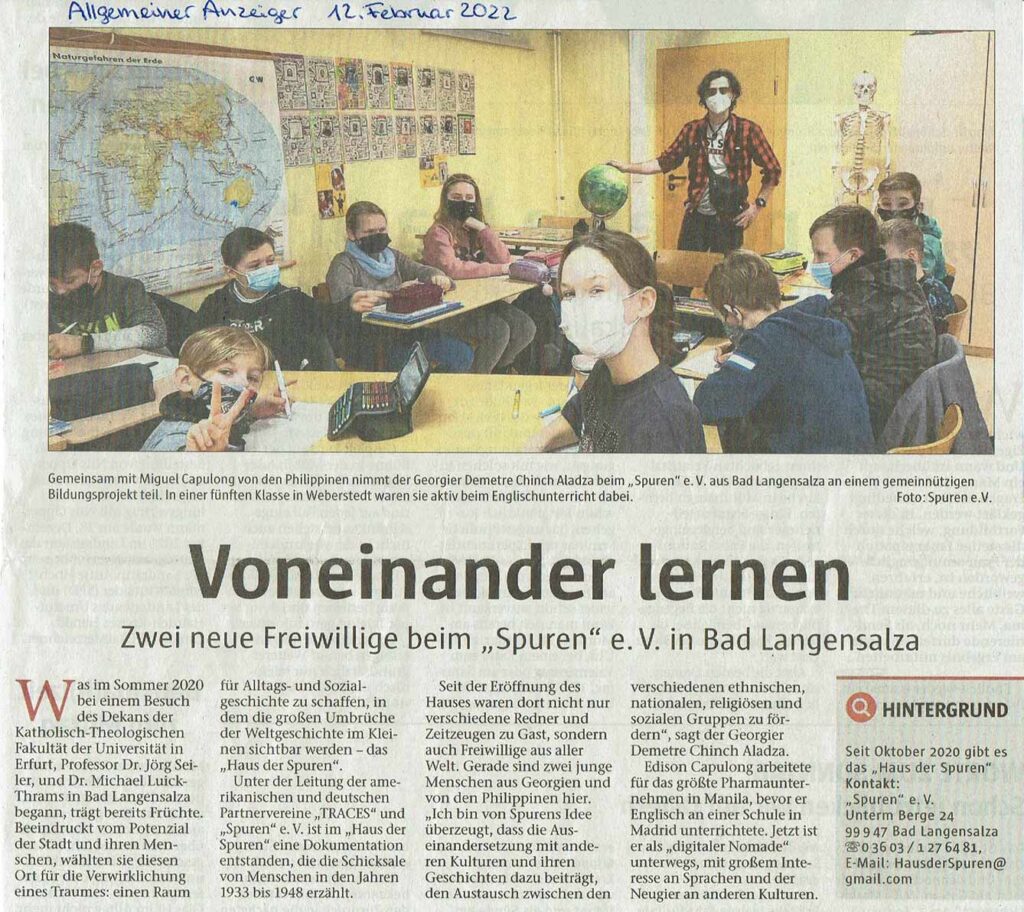
26 January 2022
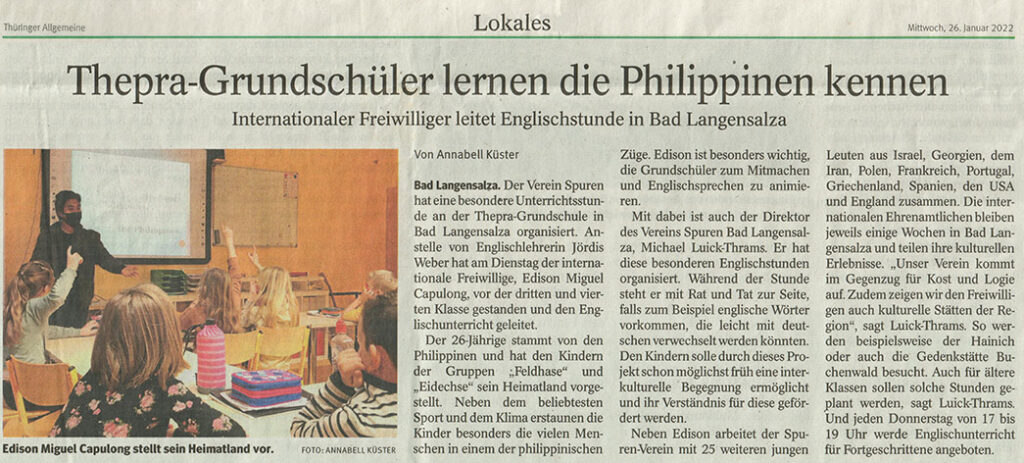
25 January 2022

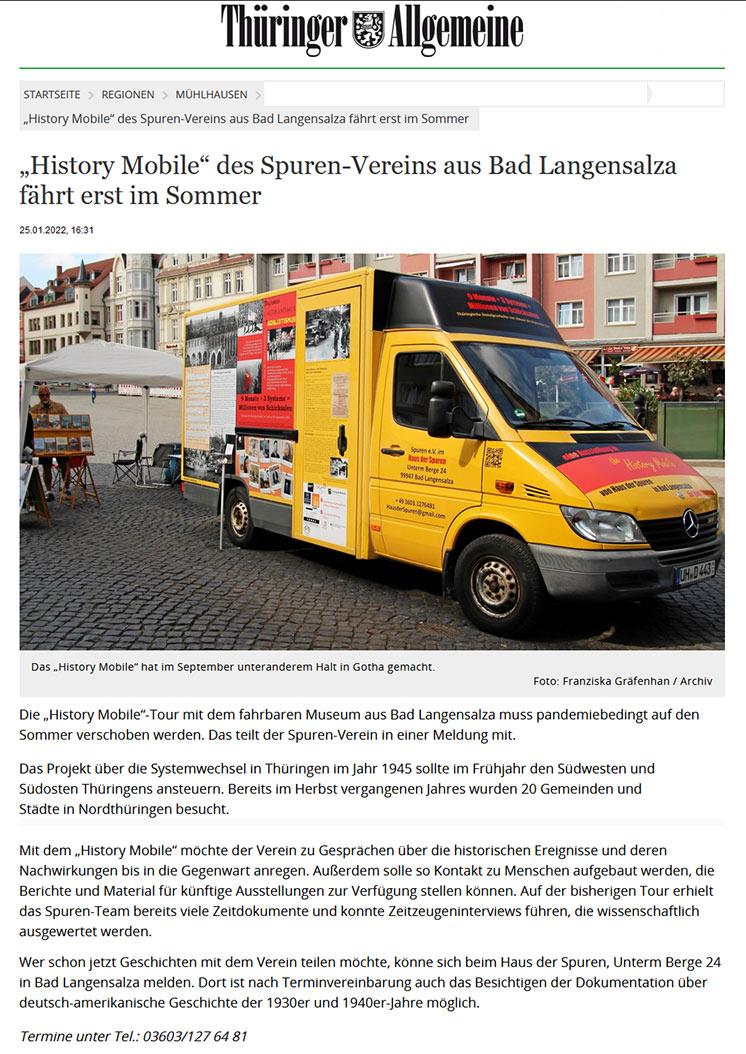
20 January 2022
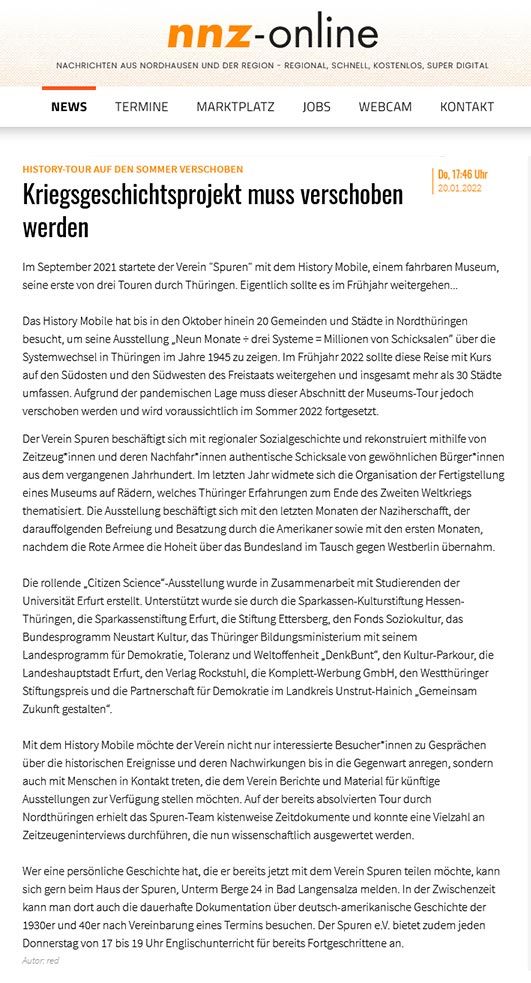
9 November 2021
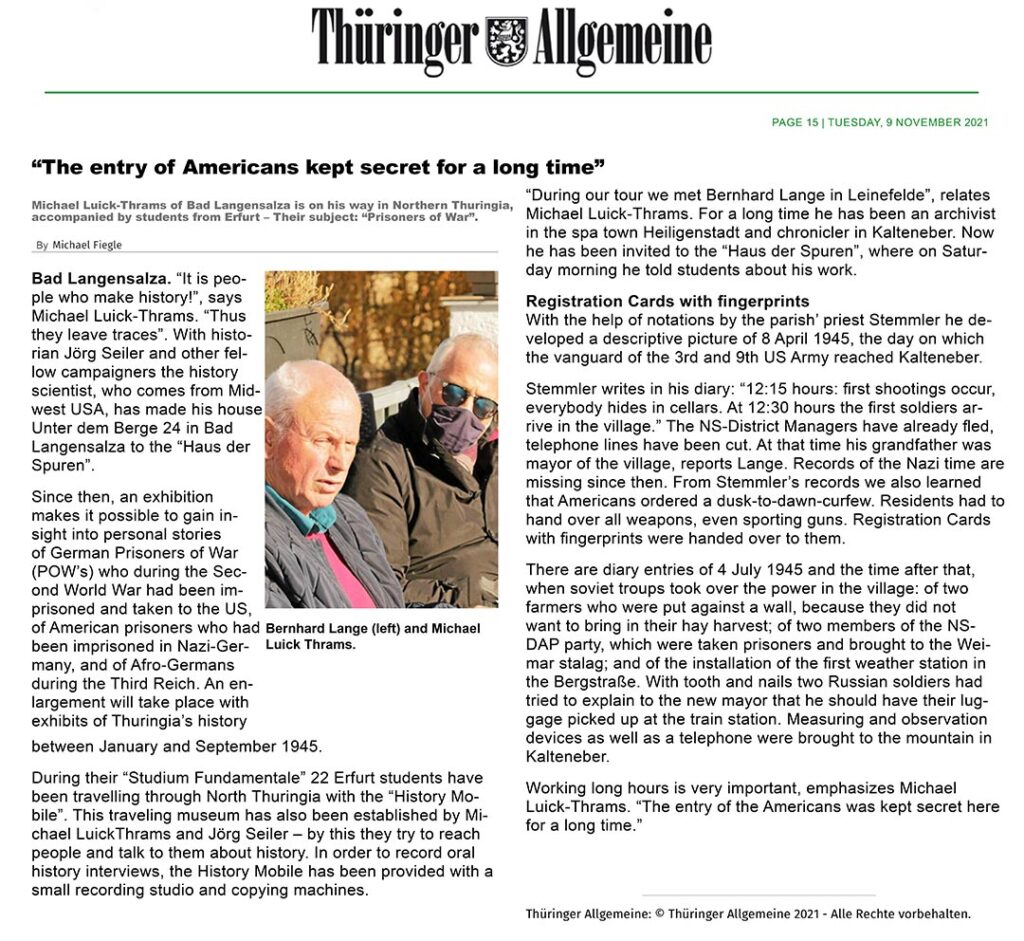
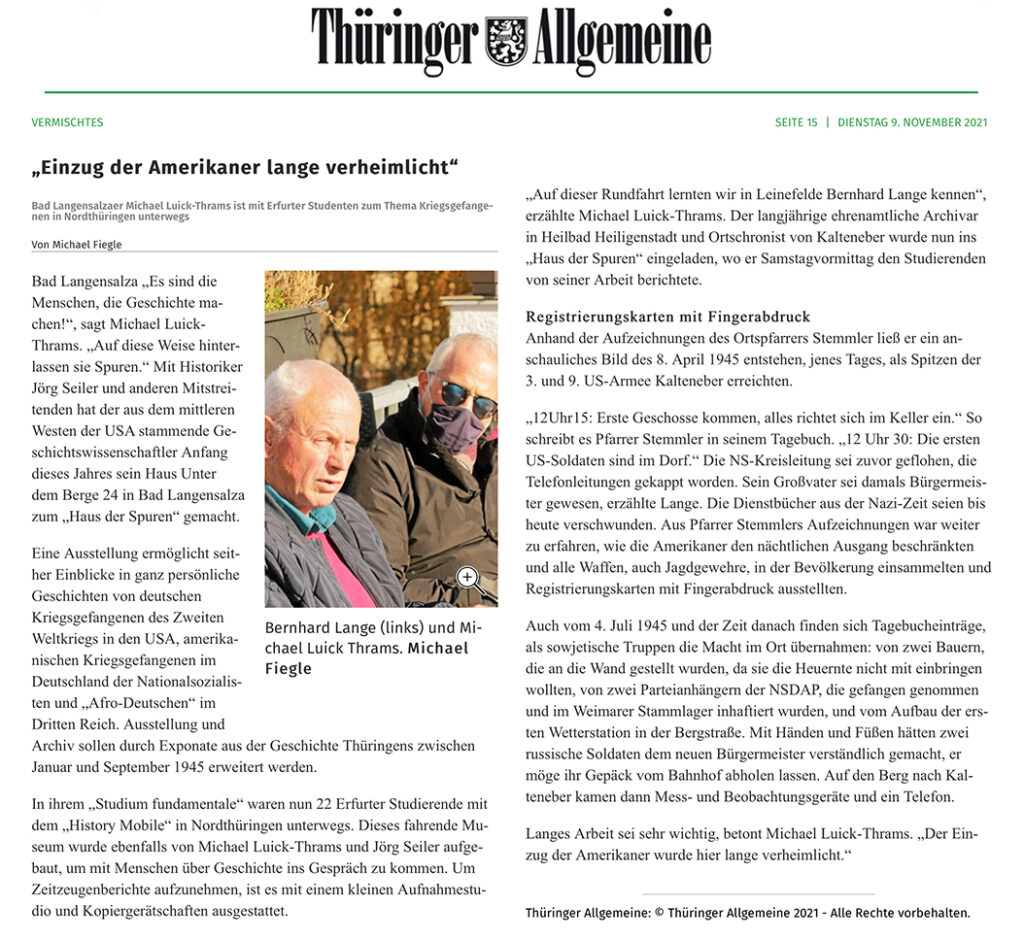
18 October 2021
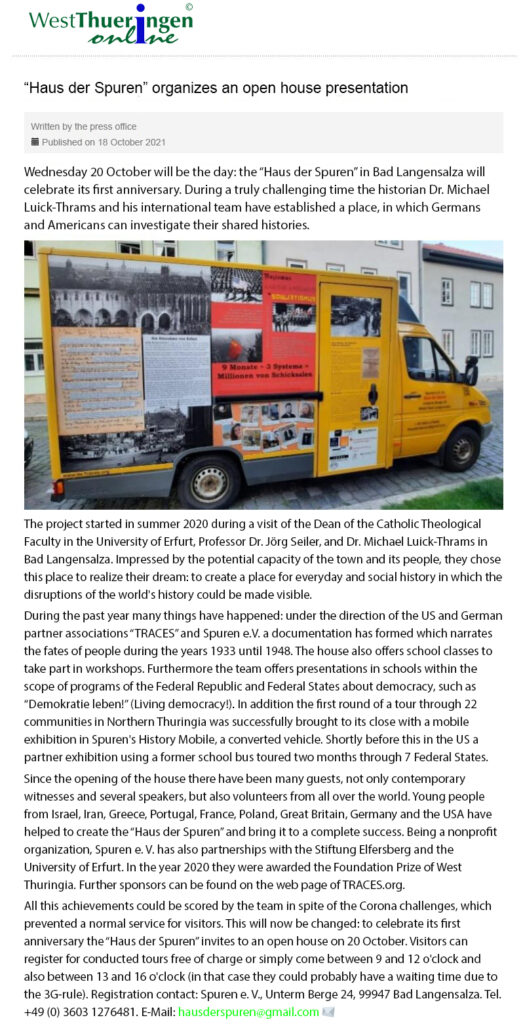
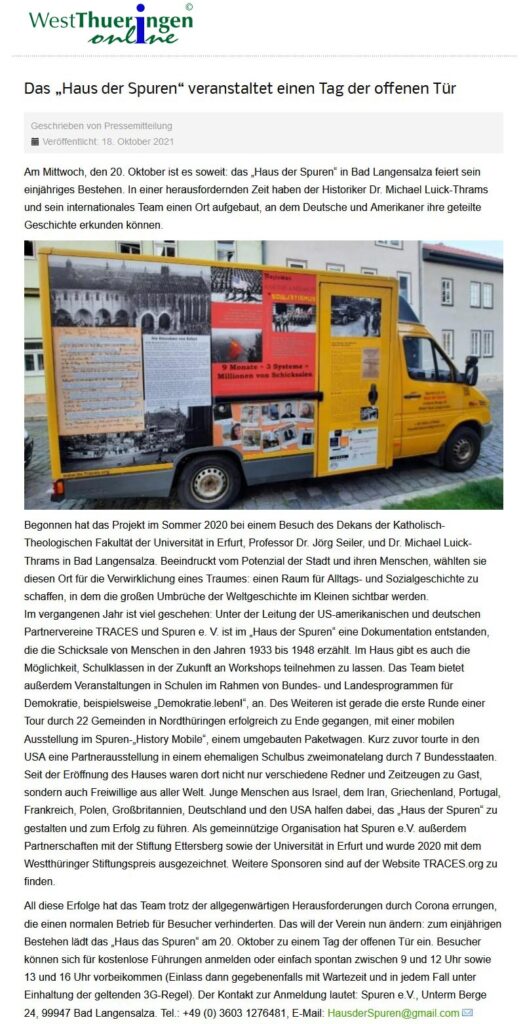
7 October 2021
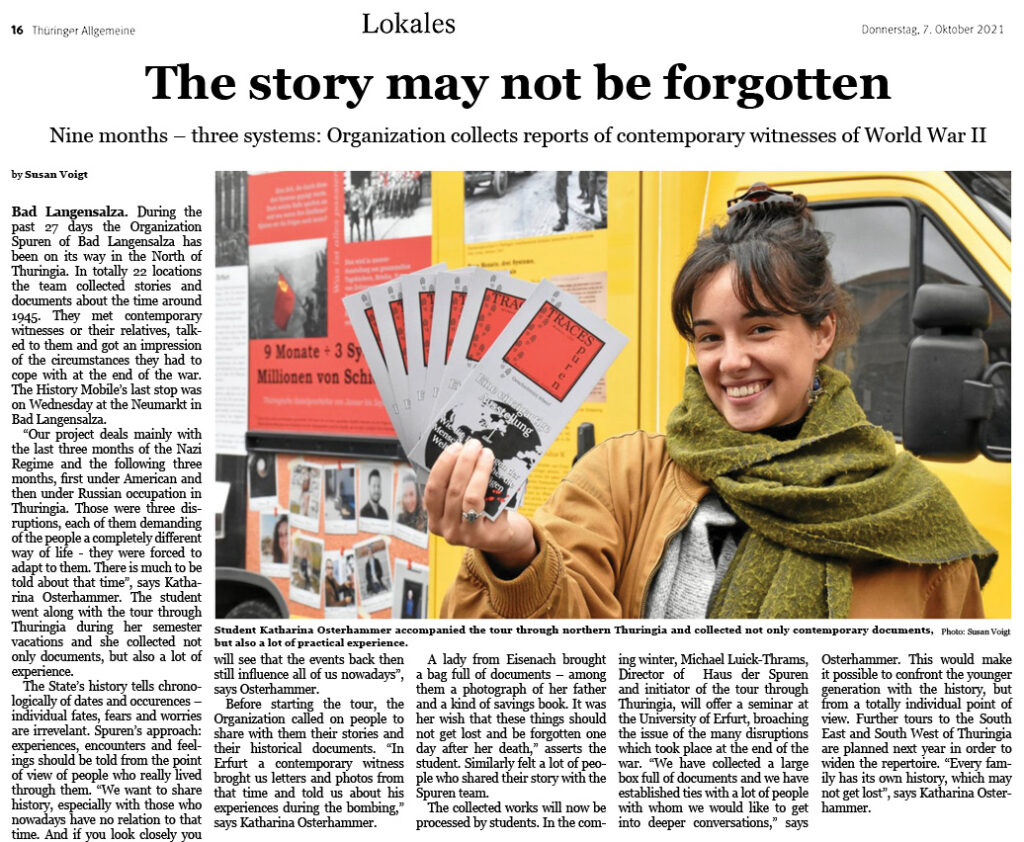

23 September 2021
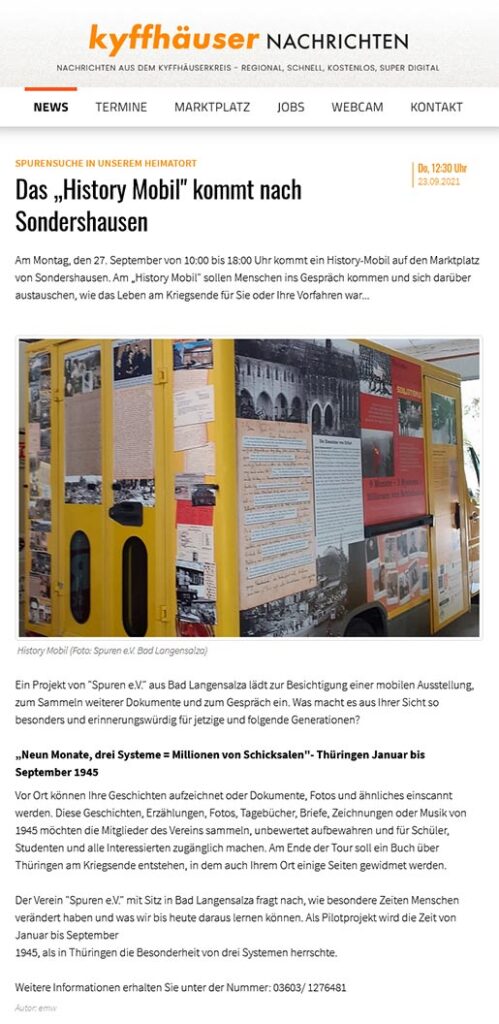
15 September 2021
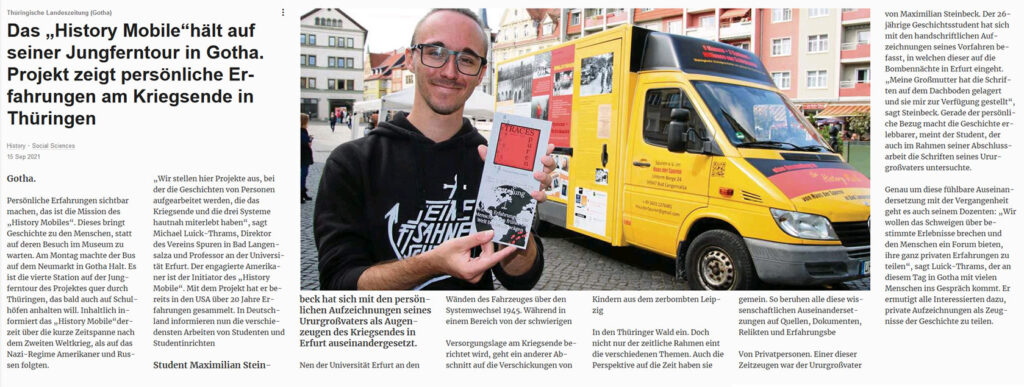
9 September 2021

8 September 2021
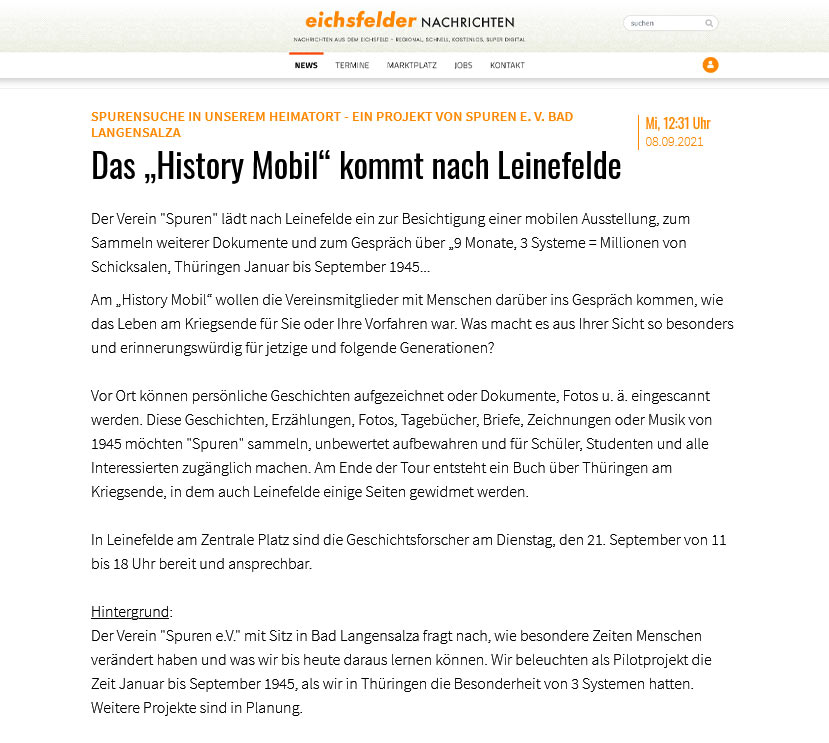
September 2021
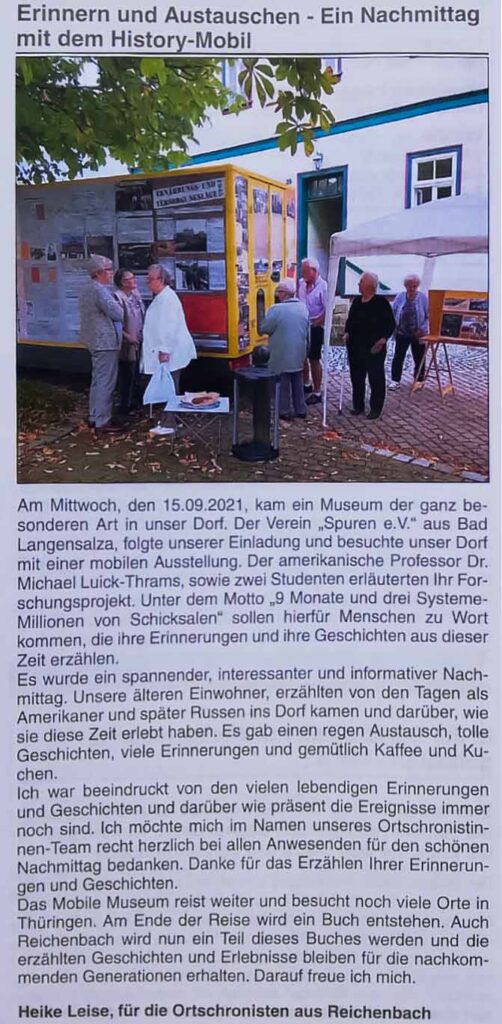
September 2021
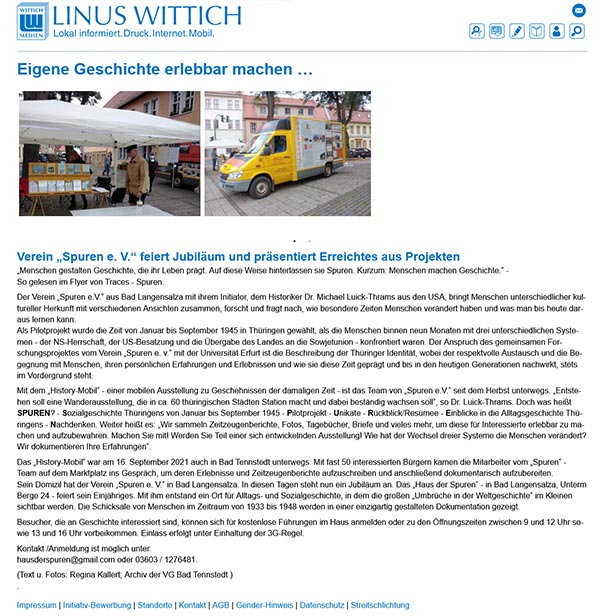
27 August 2021
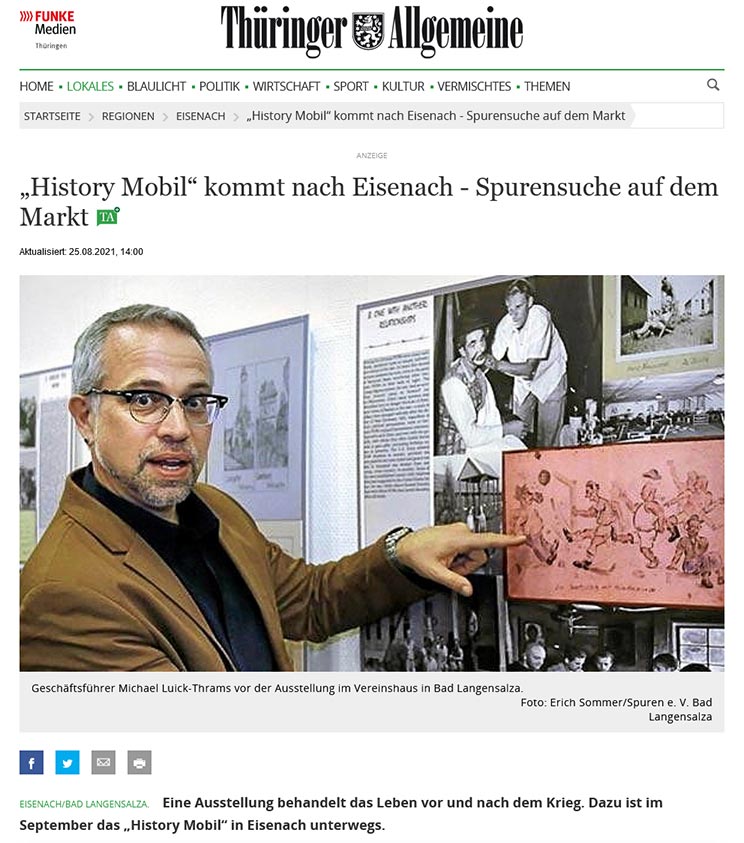
27 July 2021
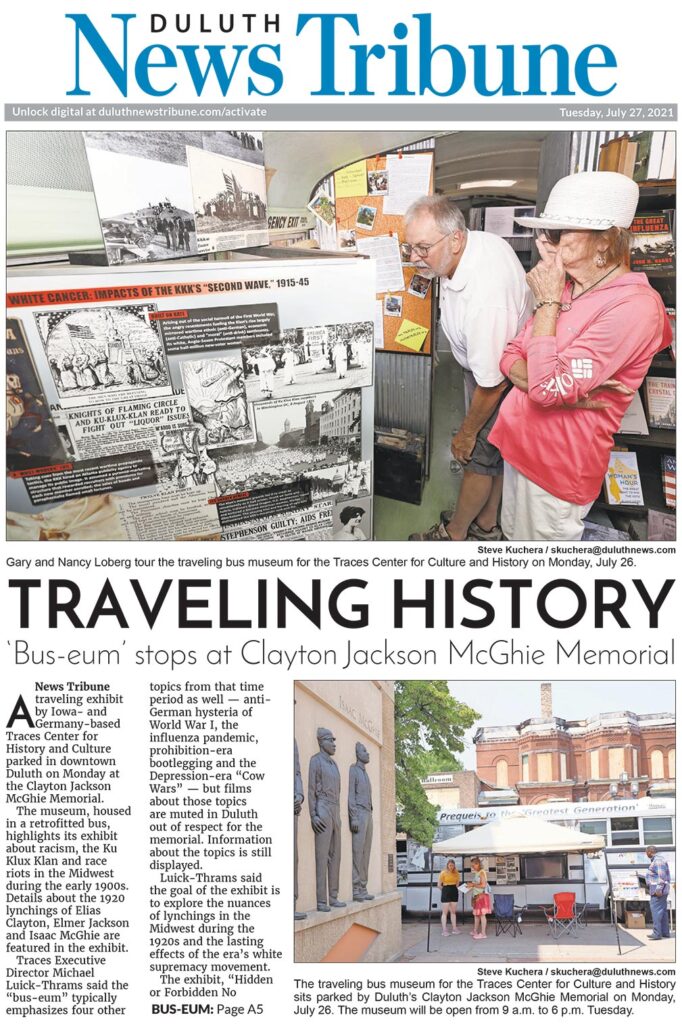
25 May 2021
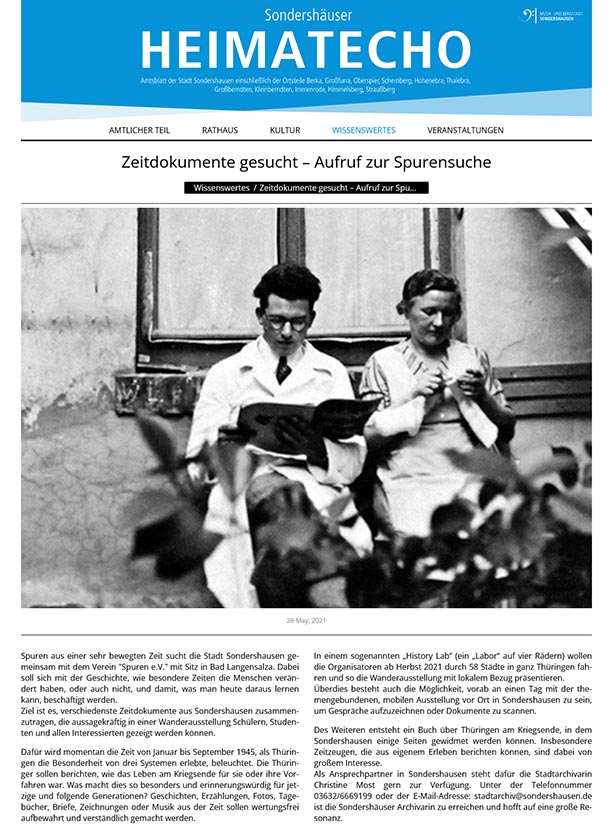
25 May 2021
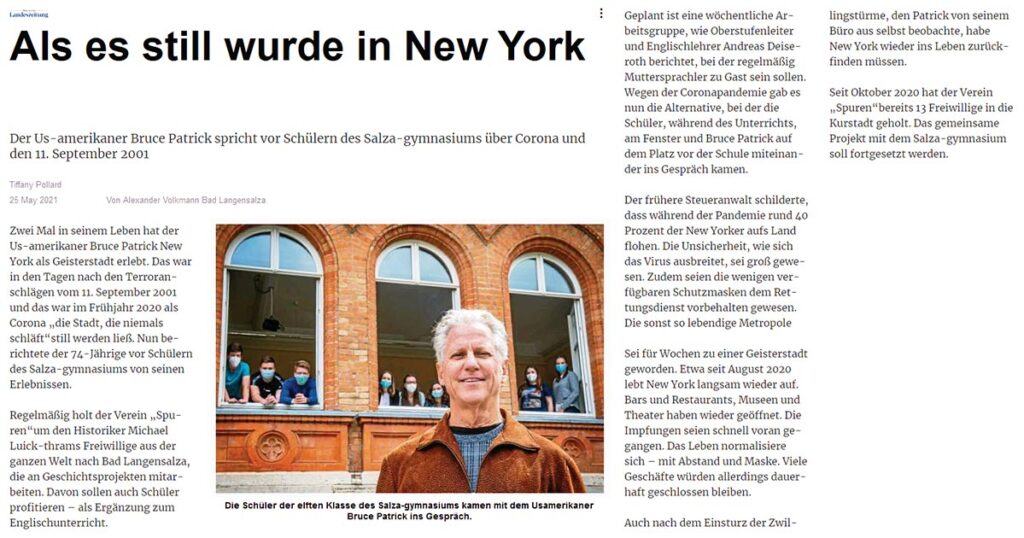
30 April 2021
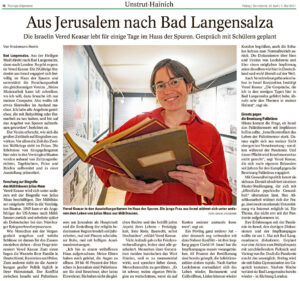
photo: Vered Kesear in the exhibition rooms of Haus der Spuren. The Israelian young woman dedicates herself, among others, to the life of Julius Mass from Mülhausen.
From Jerusalem to Bad Langensalza
The Israeli Vered Kesear stayed for a few days at Haus der Spuren.
Friday, 30 April 2021. In Thüringer Allgemeine. By Friedemann Martin
***
From the holy city, directly to Bad Langensalza, and then to London. So it goes for Vered Keasar. The 29 years old student from Israel engages as a volunteer for Haus der Spuren and supports the research work of the so-called association. “As my master thesis can be written from anywhere, I only brought my computer. I was looking for a meaningful experience abroad. I have deleted all offers that had to do with babysitting or farm work and noticed Spuren’s offer.”
The association is doing research on how the run-on of time affects biographies, with a particular focus on the World War II era. The experiences of prisoners of war, here or in the United States, are considered through eyewitness testimonies, diaries, photos, and letters, and presented in an exhibition.
Research on the biography of Julius Mass from Mülhausen
Vered Kasear will be busy with, among others, the biography of Julius Mass. Julius emigrated to the United States in 1936. In 1945 he came back to Mülhausen as a member of the US Army and worked later as an interpreter for the Nuremberg war crimes trials.
How people deal with the past and what conclusions they draw from it in order to live together – this is the question that interests Vered Keasar. On the one hand, her family roots are in Germany, Romania, and Poland. On the other, she sees the effects of high-level politics every day in her hometown. The conflict between Israelis and Palestinians over Jerusalem as a capital city and the settlement of the religiously significant region has been simmering for decades, sometimes with phases of apparent calm, sometimes with violent confrontations.
“I grew up in a cosmopolitan home. My parents taught me to keep my eyes open. 30 to 40 percent of the people in Jerusalem are Palestinians. They occupy houses but cannot be considered as inhabitants of the city. They do not have the same rights as us and this concerns every aspect of their lives – freedom of movement, freedom of speech, making laws, even weddings”, Vered Keasar explains.
There have been many attempts at peace negotiations, but all have failed so far. People of their generation now avoid the word peace – perceived as too grandiose – and prefer to talk about granting human rights. “It is hard to protect my own privileges when they come at the expense of others”, she says.
A privilege of a totally different kind – though still closely related to the Middle East conflict – is her vaccination against Covid-19. Israel has massively pushed the vaccination campaign. 60 percent of the population has already been vaccinated, and infection rates are falling rapidly. After several tough lockdowns, life is finally back to normal: restaurants and cafes open, stores welcome customers again, and schools return to normal. Discussions about the sense and nonsense of lockdowns and a possible compulsory vaccination are the same as here in Germany, and probably all over the world.
Conspiracy theories are also in vogue in Israel, Vered Kaesar confirms. “The conversations I have had in the few days here in Bad Langensalza are very similar to the topics in my homeland”, she says.
Outreach against the Occupation of Palestine
There is also the question of whether Israel should help the Palestinians with vaccine doses. “Israel strongly controls the lives of the Palestinians. From my point of view, this results in a certain responsibility – especially during the pandemic. A duty that Israel is not fulfilling at the moment”, says Vered Kaeser, who has been involved in the fight against the occupation of Palestine for years.
Vered Kaeser knows a few things about health policy. She is currently pursuing a master’s degree, in what can be translated as “public mental health”. Her thesis is devoted to the question of the extent to which emotional support is possible via the Internet; a topic that did not just come up with the pandemic. Her experiences with the pandemic in Israel, the discussions there, and the vaccination campaign: Vered Kaeser wanted to discuss those issues with Bad Langensalza on May 1. The plan was to have a spring cleaning, followed by a picnic and a presentation given by her. But the pandemic makes that impossible. Friday she will talk with Salza-Gymnasium. Next week she will leave Bad Langensalza again – for London.
Translated from German by AH.
13 April 2021
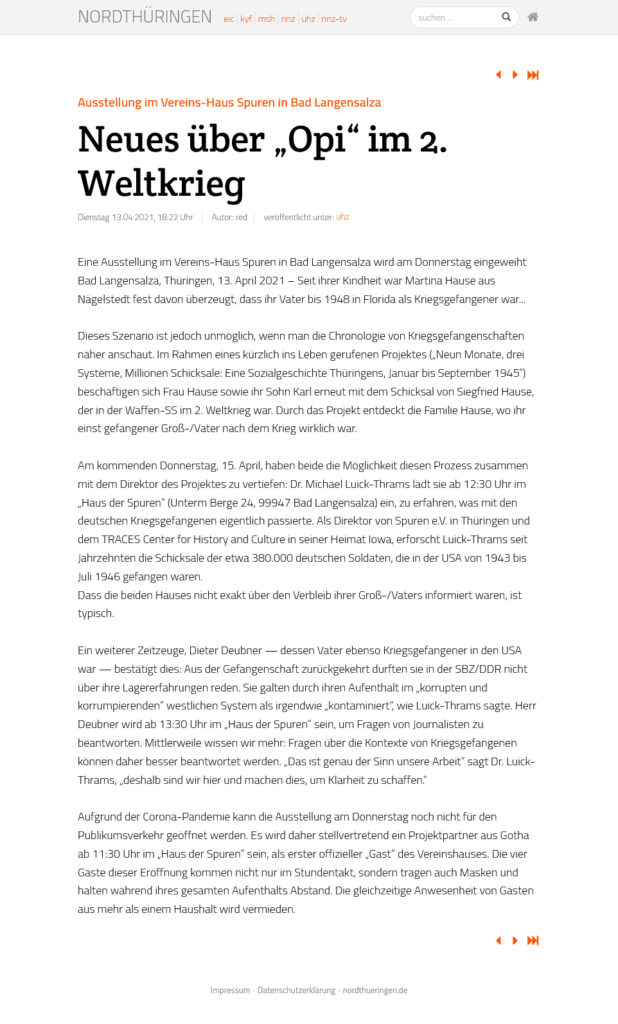
9 April 2021

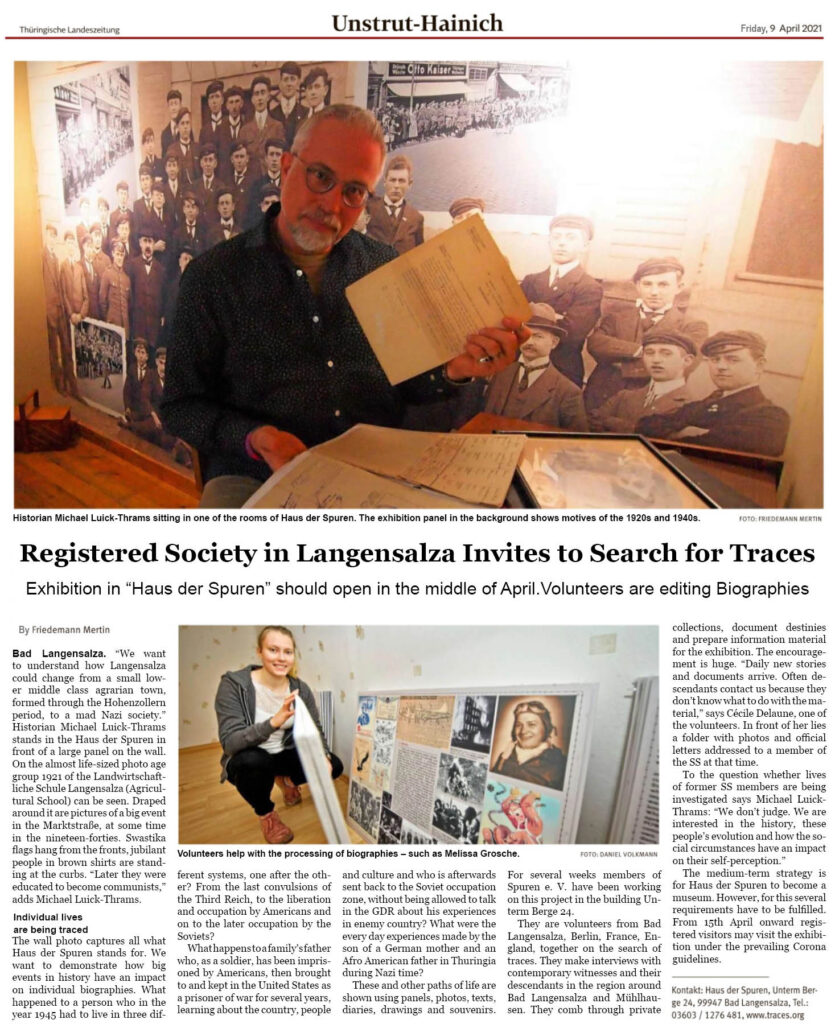
30 March 2021
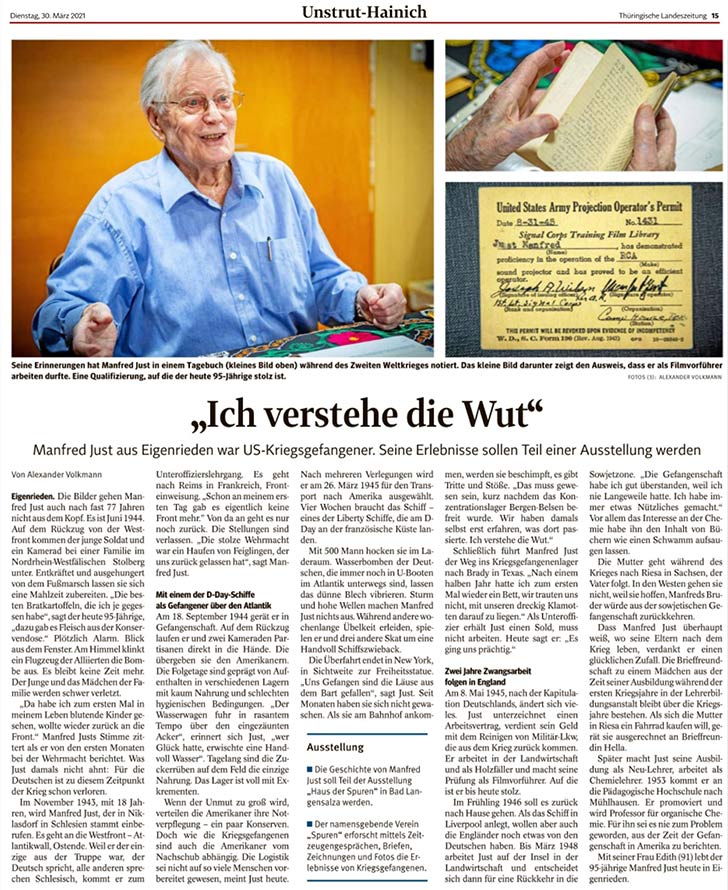
27 March 2021
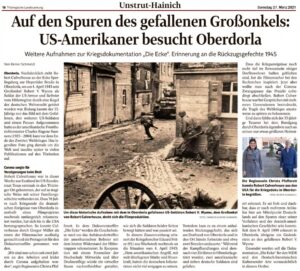
photos:
middle: The film production refers to this historic photo of US soldier Robert V. Wynne, great-uncle of Robert Culverhouse, who was killed in action in Oberdorla.
right: Producer Christa Pfafferott greeted in Oberdorla Robert Culverhouse, who came from the US for the war documentary.
FOLLOWING THE TRACES OF HIS GREAT-UNCLE KILLED IN ACTION:
US AMERICAN CITIZEN VISITS OBERDORLA
Further Photos for the War Documentation “The Corner” (“Die Ecke”).
Memories of the Retreat Battle in 1945
By Reiner Schmalzl
Oberdorla.
Robert Culverhouse thoughtfully stands at the corner of Sperlingsberg and Heyeröda Straße in Oberdorla, where on 4 April 1945 his great-uncle Robert V. Wynne, a soldier in the US Army and liberator from the Hitler regime, was killed by a bullet from the German Wehrmacht (Armed Forces). Until now the 35-year old only knew the photo showing the killed soldier, three other US soldiers, and a tank. The photo had been taken by Charles Eugene Sumners (1923-2004), a war correspondent shortly before the end of World War II. At that time this legendary photo went around the world and later appeared on the front covers of many publications.
Due to Corona, the Shooting was delayed.
That week for the first time Robert Culverhouse had come from Eastland, Texas to this village in Thuringia which is connected to his family history in such a tragic way. The fact that 76 years after the end of the war the dramatic events of Oberdorla were going to be extensively reconstructed in a film documentary had gotten around in the US. Thus Gregor Müller, one of the filmmakers, could locate Culverhouse who became the protagonist of the film.
“We have been working on the film for two years, but were stopped by Corona”, said director Christa Pfafferott. In the documentary “The Corner” the events about the fighting between the American liberators and the last resistance of the Hitler troops are being reconstructed. In cooperation with a forensics expert of the Mittweida High School and using a drone, a virtual room could be comprehensibly constructed, showing how soldiers on both sides could have moved and what could have happened.
In this context 91-year-old war researcher Eduard Fritze from Wachstedt remembers the situation on 4 April 1945: the German foot soldiers could not really withstand the American attack which had far more force and firepower. Nevertheless, it came to a persistent retreat battle, which continued from the edge to the middle of the village and lasted for about two hours. According to him, during combat operations four civilians of Oberdorla were killed two American and seven German soldiers died in action.
Inspired by the fact that war events are still very deep in the memories of some of the villagers, the filmmaker started his research work. Now, after the mandatory break due to Corona, it is essential to bring the project to a close. During his conversations with many generations of villagers, Robert Culverhouse was impressed by feeling a little of the tragedy of World War II.
During his walkabout in Oberdorla, the 35-year-old Texan was also reminded of his hometown, although that is somehow larger. He is very happy and grateful that after several attempts to come here to the center of Germany, he has finally found traces of one of his ascendants and of German-American history. By the way, since 9 April 1999, a memorial stone in Oberdorla reminds us of Robert V. Wynne, killed in action in this village.
Broadcast of the documentary “The Corner” will probably be next autumn in the MDR (Mitteldeutscher Rundfunk) and the French culture TV Station ARTE.
Translated from German by Karin Schramm.
18 March 2021
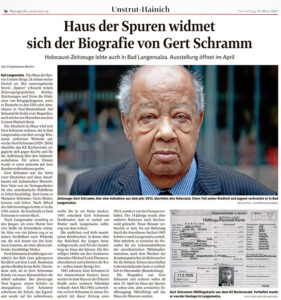
top photo: Contemporary witness Gert Schramm – a photograph made in 2005 –survived the Holocaust. In Bad Langensalza he spent part of his childhood and youth.
bottom photo: Häftlings-Personal-Karte – Gert Schramm’s Prisoner Card from the Buchenwald Concentration Camp
Unstrut-Hainich
“HAUS DER SPUREN” ATTENDS TO THE BIOGRAPHY OF GERT SCHRAMM
Contemporary Witness of the Holocaust also lived in Bad Langensalza. Exhibition opens in April
by Friedemann Mertin
18th March 2021
The “Haus der Spuren”, Unterm Berge 24, takes further shape. The History Society “Spuren”, which is the name giver for the house, investigates the experiences of prisoners of war, either Germans in the United States or Americans in Nazi Germany, based on talks with contemporary witnesses, letters, drawings, and photographs. The biographies will be found on presentation boards, as well as those of people from the district of Unstrut-Hainich.
Part of the house will be dedicated to Gert Schramm (1928 – 2016), who grew up in Bad Langensalza and in Witterda, which is only a few miles away. He survived the concentration camp in Buchenwald, engaged himself against fascism, and wanted to enlighten National Socialism. For his engagement he received the “Bundesverdienstkreuz” (Federal Cross of Merit).
Gert Schramm was the son of a German woman and an American man with Cuban roots. His father came to Erfurt as a contract worker for an American Steel Company. There he met Marianne Schramm, Gert’s mother, and fell in love with her. After finishing his contract work he returned to the US, as Gert Schramm writes in his book.
The boy came to Langensalza when his mother found a job as a dressmaker. Aged four, he moved to his grandparents in Witterda, who could take better care of him than his working single mother.
According to Gert Schramm, he spent his childhood safely in the country. Apparently, there was no racism. Unfortunately, that changed when a new school teacher took over. The committed Nazi began to harass his pupil. Gert Schramm ditched school and the Youth Welfare Office started to take notice of the boy and wanted to put him in a Youth Institution. In 1941, Gert Schramm’s grandmother decided to send him back to his mother in Langensalza, away from the teacher.
The corresponding official exchange of letters contains extremely racist taunts. In them, the boy’s fate is discussed. These letters are also part of the exhibition. Volunteers around the Chairman of the History Society, Michael Luick-Thrams, did research work and wrote the texts – establishing regional connections.
In 1943, Gert Schramm worked for the Car Repair Shop Greiner. Today, in that house in the Erfurter Straße among other things bicycles are sold.
In 2014, during an interview with this newspaper, Gert Schramm reported that on 6th May 1943, he was arrested by the Gestapo. The 14-year-old was brought to Buchenwald after having passed several stations. He stayed there for nine months until the camp was freed by Americans.
In June 1945, he returned to Langensalza, where at first he worked in a Food Storage run by the American Military Administration. After the replacement of the occupying power, he worked as a translator for the Soviets. At last, he found his permanent life center in Eberswalde (Brandenburg).
The biographies of Gert Schramm and others will be exhibited in the “Haus der Spuren”, the aimed date for its opening is 15th April 2021.
In the foreseeable future, the house will become a museum.
(PHOTOGRAPH: äftlings-Personal-Karte – Gert Schramm’s Prisoner Card from the Buchenwald Concentration Camp)
Translated from German by Karin Schramm.
20 February 2021

New Museum in Langensalza
Permission is still uncertain.
Bad Langensalza. The association Spuren will open a museum at Haus Unterm Berge 24, in Bad Langensalza. There will be presented results of research projects on the fates of prisoners of war. On Thursday, Mayor Matthias Reiz (no party affiliation) took a look at the preparations. The chairman of the association, Michael Luick-Thrams, gave a tour of the house.
Through witness interviews, letters, drawings, and photographs, the association explores the experiences of prisoners of war, whether Germans in the United States or Americans in Nazi Germany. Biographies, including those of people from the Unstrut-Hainich district, can be found on display boards.
Luick-Thrams, who works as a lecturer at the University of Erfurt, plans to open the house by Easter at the latest. The renovation work is currently underway, and the exhibition concept is in place. There are plans for seminars with students, and guides think about including the museum in their tours.
However, permits are needed for a house to be visited by the public. For example, issues of fire protection, escape routes, or parking spaces need to be clarified. All of these are yet to come. The councils want to support, Reinz said. At the same time, he warned against hasty enthusiasm. In his view, there is still a long way to go before the district’s building inspectorate can give the green light.
18 February 2021
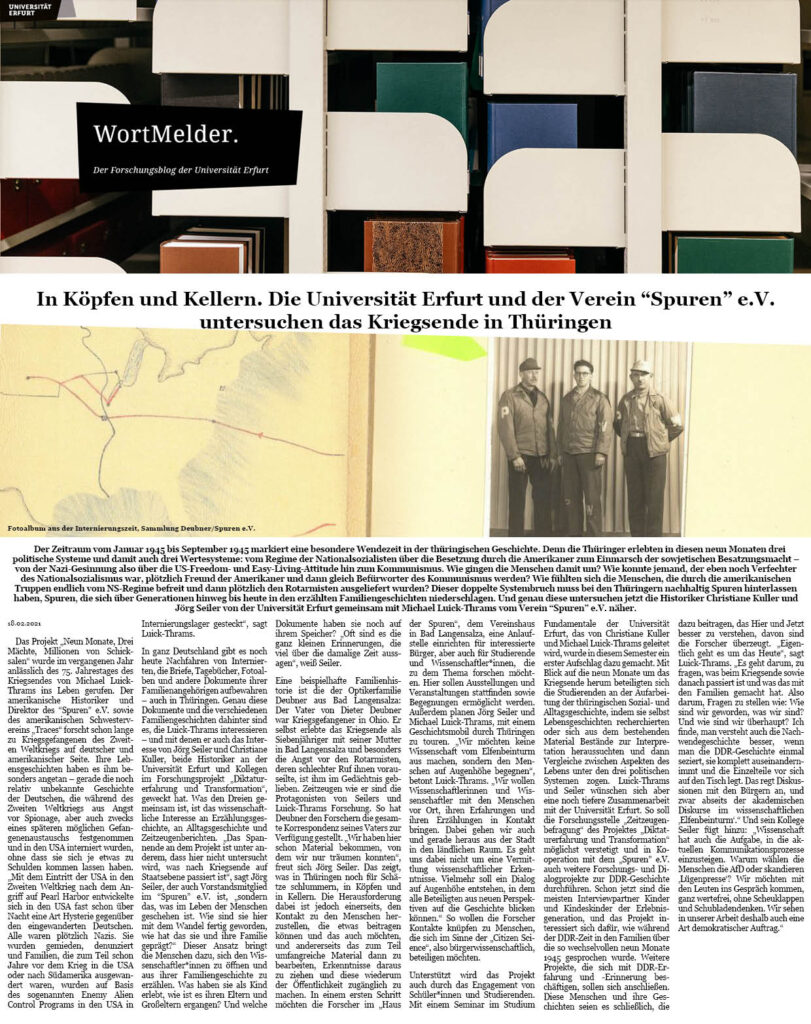
9 February 2021
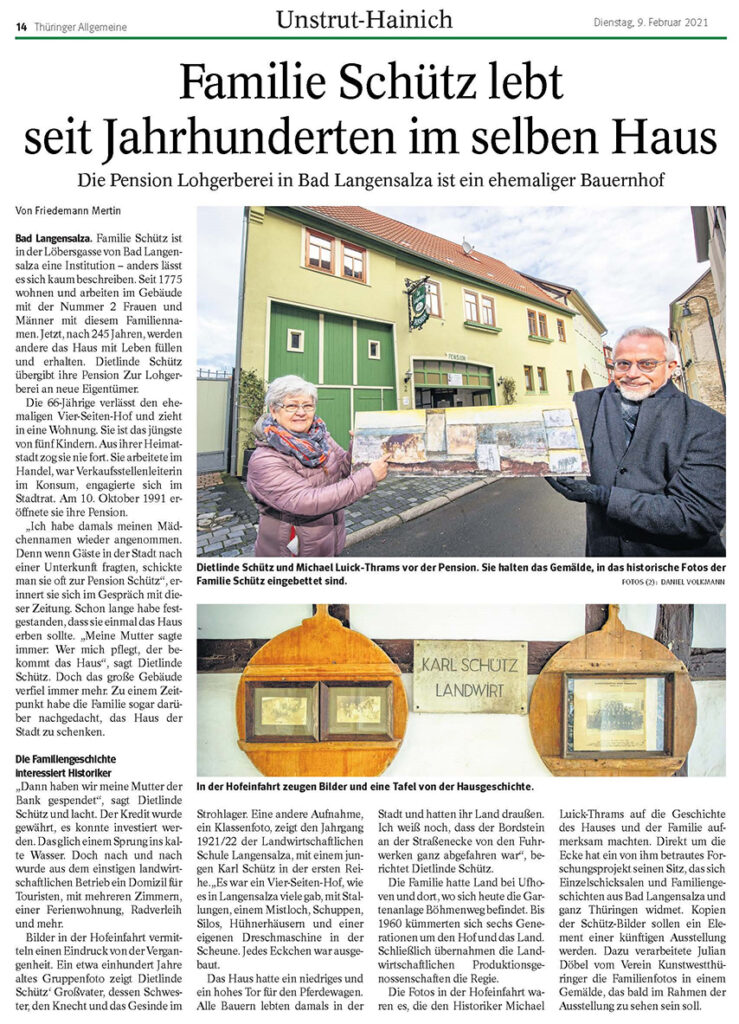
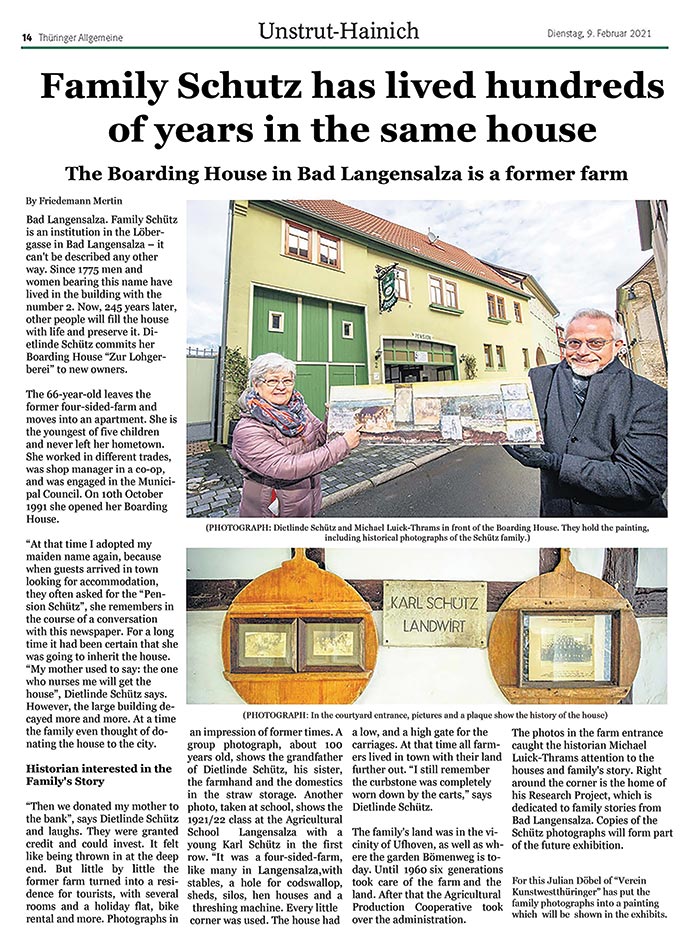
6 February 2021
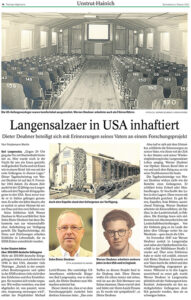
top photo: The Prisoner of War Camps in the United States were comfortable. Werner Deubner also worked as a film projectionist.
bottom photos:
1.A chapel was also available for the prisoners.
2.Son Dieter Deubner.
3.Werner Deubner worked several years in the United States and in England.
THÜRINGER ALLGEMEINE
LANGENSALZA CITIZEN IMPRISONED IN THE UNITED STATES
Dieter Deubner joins a research project using
his father’s memories
Friedemann Mertin
Bad Langensalza. “Approximately at midnight, the barbed wire gate closed behind me. Even though it was late, we were served a dinner like in a hotel, the tables were covered with white tablecloth. I was one of the first prisoners in this camp.” This entry in the diary of Werner Deubner is dated 9th November 1943. At this point, the 32-year-old Werner Deubner from Langensalza had been in the United States for three days as a prisoner of war. A short time before that, he was imprisoned in Italy. It would take four years before he could return home to his wife and two sons.
Werner Deubner recorded his experiences in words and images. His son Dieter Deubner has made available these documents to be scientifically processed. The diary entries, photos, and drawings provide an insight into histories that were suppressed during GDR times.
More than 300.000 German Prisoners of War lived in the United States
More than 300.000 German prisoners of war lived and worked in the United States until 1946, among them many men from Thuringia. “Back in the Russian Zone and later in the GDR many didn’t speak about their experiences and attitudes. They had to readjust to the new situation. “We want to understand what happens when a readjustment is enforced”, explains Project Manager Michael Luick-Thrams, who is always on the go. The American, who in the meantime has become a citizen of Bad Langensalza, was the one who could induce Dieter Deubner to take part in the project.
Dieter Deubner concedes that at the beginning he was not at all interested in the project. “The first meeting regarding this project took place in the Dryburg. “I had always wanted to see those rooms, as they date back to the time of Hermann von Salza. When I was there and heard what Mr. Luick-Thrams had to say, I found him likable”, says Dieter Deubner.
Thus he agreed to meet the historian, narrated the memories of his father and how he handled his time in the States, and his readjustment with life in Langensalza. Werner Deubner was an optometrist and he practiced this profession before and after the war, as do his descendants up to now.
Werner Deubner’s diary entries don’t seem to be an account written by a prisoner of war. He doesn’t describe any atrocities or mistreatment. He describes life in the different camps. These were secured with barbed wire. There were movies, chapels, permanent huts, and sufficient food. Werner Deubner worked as a film projectionist and an optometrist, as well as in farms and factories. His entries read like descriptions of adventures and landscapes. In the course of the years, he came from the East Coast over Chicago to the West Coast – across the United States.
In November 1947 Werner Deubner returned to Langensalza and to his profession as an optometrist in his shop in the Mühlhäuser Straße 3. He never told much of his experiences, remembers Dieter Deubner. On the one hand, he was very busy with his job and the difficult postwar period. Whilst in the camps there was always enough food, he was suddenly confronted with the want of nourishment in Langensalza. On the other hand, they were told upon their return that they had to keep silent.
Translated from German by Karin Schramm.
16 December 2020
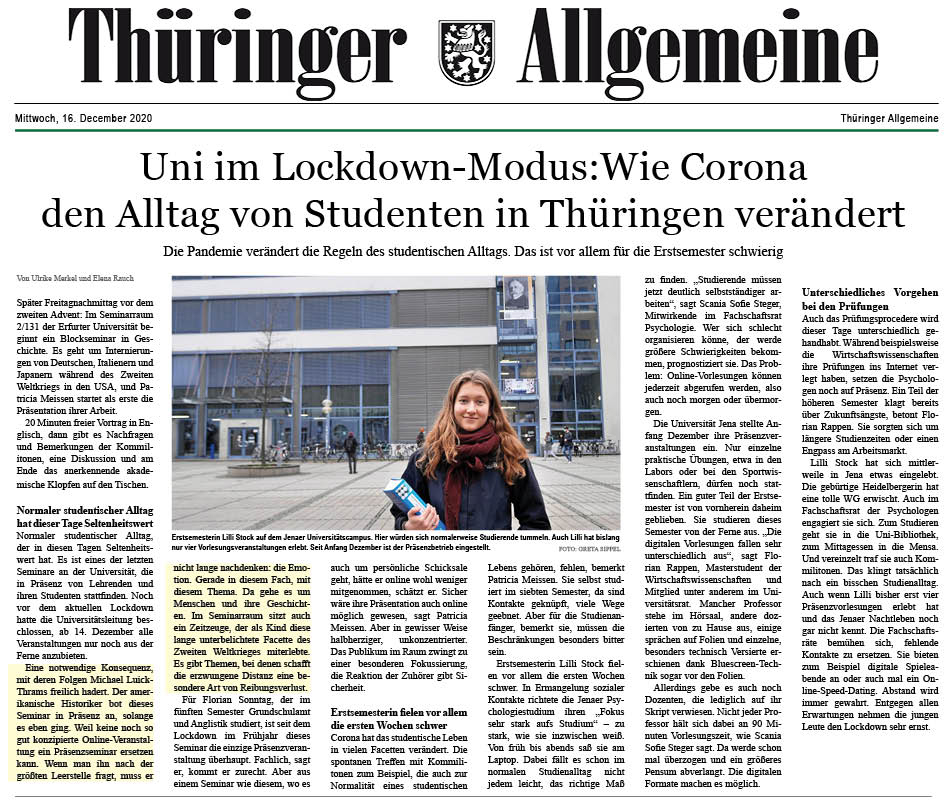
P.M. History Spurensuche 2020
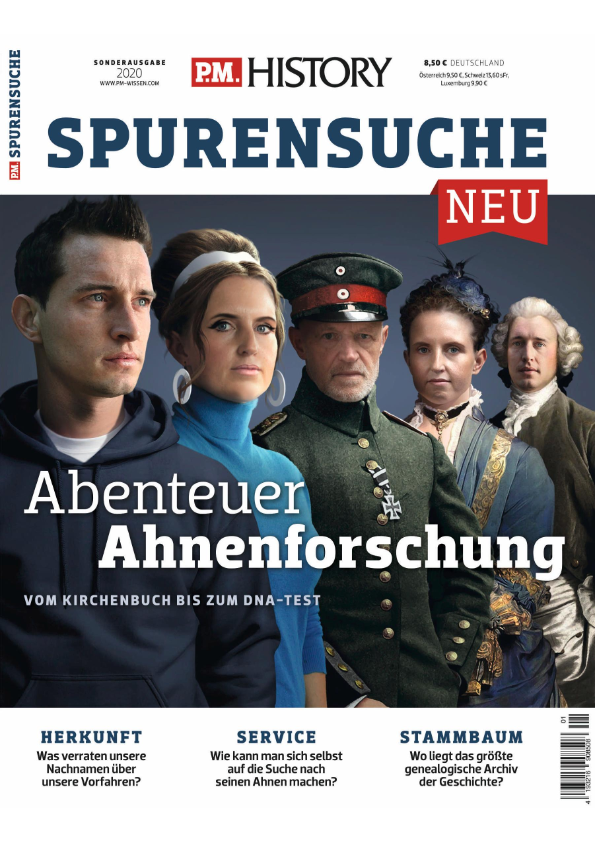
21 November 2020
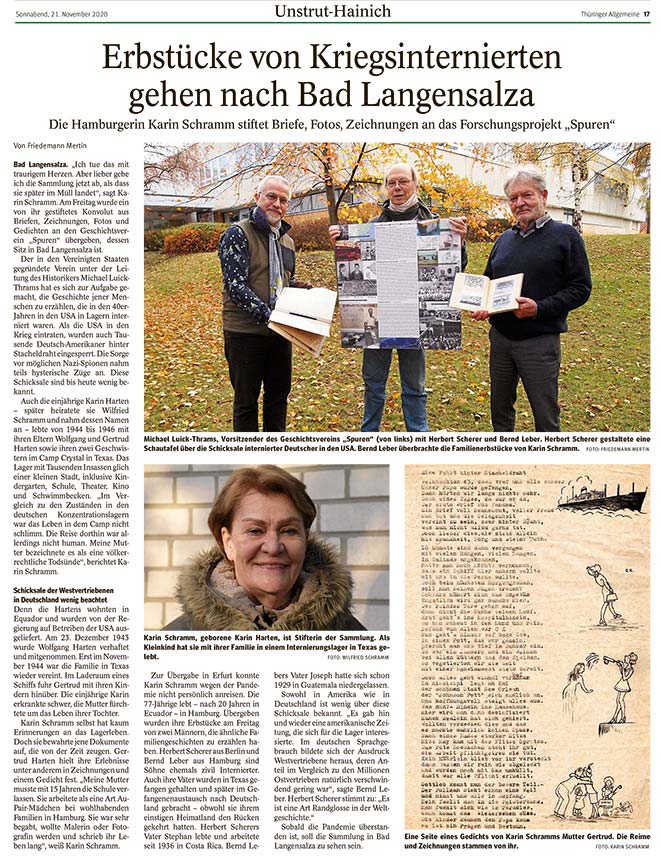

6 November 2020
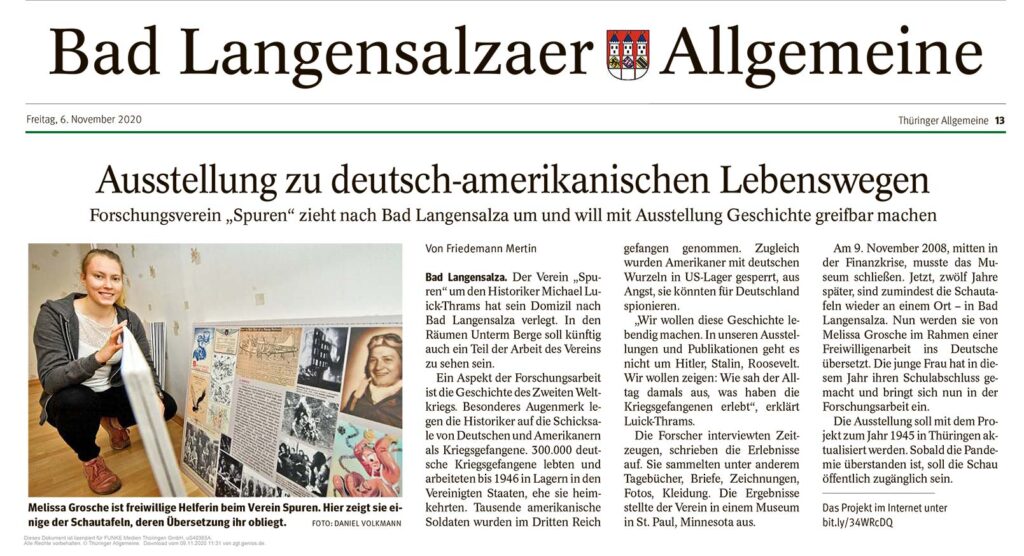
BAD LANGENSALZAER ALLGEMEINE
Friday, 6 November 2020 Thüringer Allgemeine
EXHIBITION COVERING
GERMAN-AMERICAN LIFE PATHS
Registered Society “Spuren” moves to Bad Langensalza and will make history palpable in an exhibition
By Friedemann Mertin
Bad Langensalza. The Registered Society “Spuren” around historian Michael Luick-Thrams has moved to Bad Langensalza. Henceforth a part of the Society’s work will be shown at the address Unterm Berge.
A facet of the research work is the history of World War II. Special attention has been turned to the fates of Germans and Americans during their time as prisoners of war. 300.000 German prisoners of war lived and worked up to 1946 in camps in the United States before they could return home. Thousands of American soldiers were imprisoned in the Third Reich. At the same time, American people with German roots were confined in US camps – the reason for this was the fear that they could be spies for Germany.
“We want to roll back the years and make this history alive. Our exhibitions and publications will not be about Hitler, Stalin, or Roosevelt. We want to show everyday life at that time, what the prisoners of war experience”, says Michael Luick-Thrams.
Researchers have interviewed contemporary witnesses, and have written down their experiences. They also collected diaries, letters, drawings photographs, and clothes. All these were shown in a museum in St. Paul, Minnesota.
On 9 November 2008, in the midst of the financial crisis, the museum had to close. Now, twelve years later, at least the panels have been brought to a location – in Bad Langensalza. Melissa Grosche, working as a volunteer, is translating them into German. The young woman has finished school this year and is now involved in the research work.
An update of the exhibition is planned together with the project dealing with the year 1945 in Thüringen. As soon as the pandemic is over, the exhibition will be opened to the public.
The project can be found on the Internet under bit.ly/34WRcDQ
Translated from German by Karin Schramm.
2 January 2020
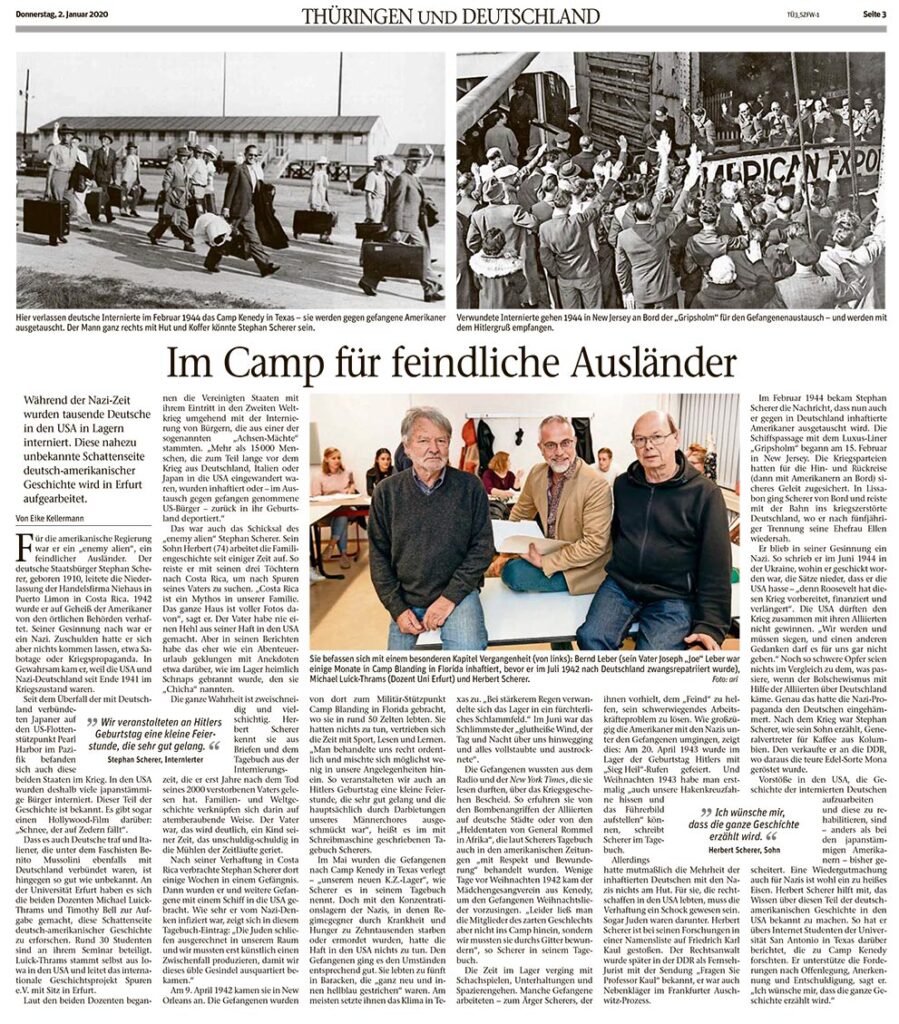
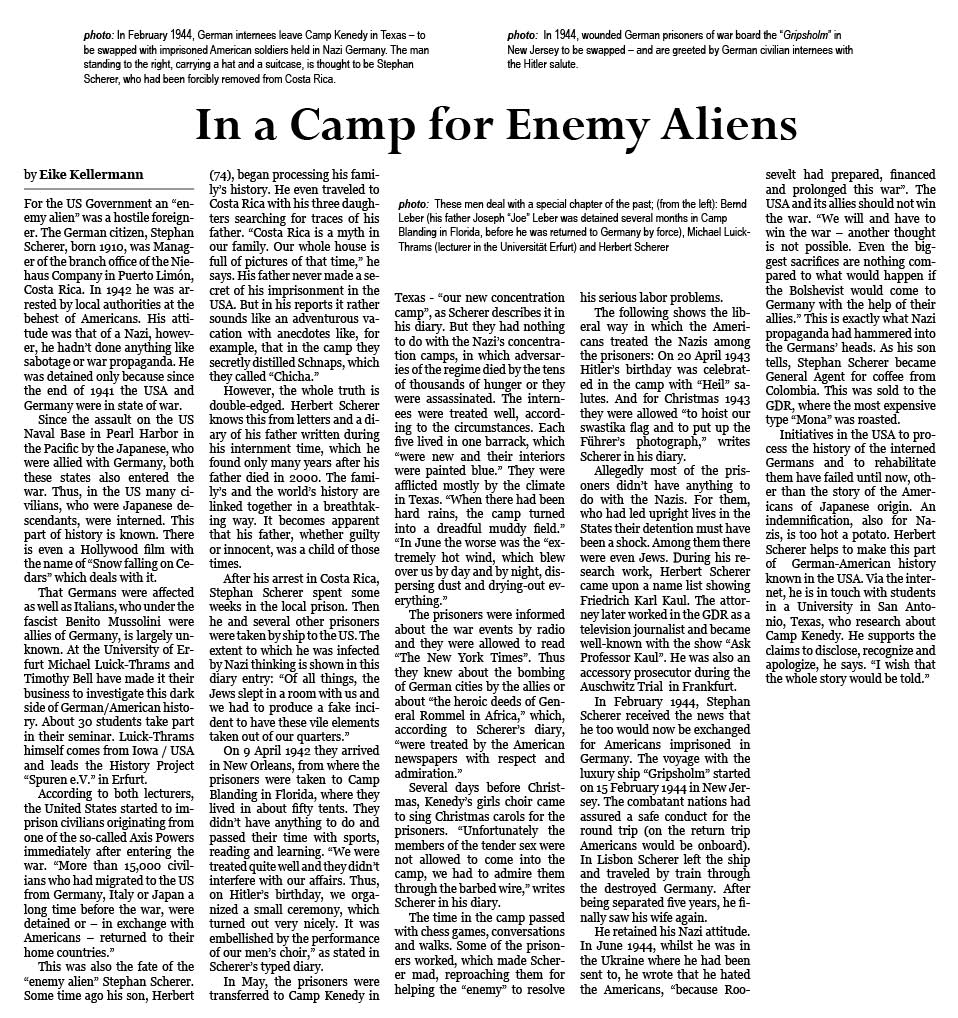
16 October 2020
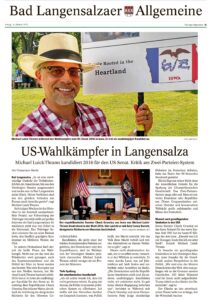
photo: Michael Luick-Thrams during the election campaign for the US Senate 2016 in Iowa. He lined up as an independent candidate.
BAD LANGENSALZAER ALLGEMEINE
US – ELECTOR IN LANGENSALZA
Michael Luick-Thrams lined up 2016 for the US Senate.
Criticism about the Two Parties System
By Friedemann Mertin
Bad Langensalza. “It is a strange reversion of circumstances. I am an American who emigrated from the United States, seeking my luck now in Bad Langensalza. My ancestors emigrated from Europe to America due to the same reasons”, says Michael Luick-Thrams.
For a couple of weeks the historian has been omnipresent in the town. His research project regarding the Thuringian identity is met with huge interest by the people in Bad Langensalza. He is now moving from Erfurt to this small town. The Thuringian valley reminds him of his homeland Iowa, a Federal State with a rural environment in the Midwest of the USA.
At present the hot phase of the election is taking place in his home country. The campaign is not only for the Presidential Chair, but also for the House of Representatives and for a third of the seats in the Senate. Many Europeans know about the US elections only from the media, but Michael Luick-Thrams has experienced them closely. 2016 he lined up in Iowa as an independent candidate for the Senate. He lost against the Republican Chuck Grassley, the man who currently heads the Hearing of the nominated Judge for the Supreme Court.
Candidates who do not belong to one of the two dominant parties, either the Democrats or the Republicans, do not stand a chance in the US voting system. Michael Luick-Thrams received less than one percent of the votes.
American Society is deeply divided
“When I lined up I knew that I wouldn’t win. I just wanted to reveal the faults in our political system. I wanted to talk to people about the meaning of politics, how power is generated, how folks distribute this power and about the alternatives to this procedure”, he says.
He tried to convey to the voters this rather academic approach, as he says. He traveled through the country, appeared in fairs, delivered speeches and propagated his opinions in radio stations, “The Democrats and Republicans ignored me and the other independent candidates, we did not even exist for them. There were no direct encounters,” he says. Whilst Chuck Grassley and his contender Patty Judge had one-hour long debates in TV, the radio station allowed him only 90 seconds of broadcasting time.
According to him, this is one of the main reasons for the division in the American society. The two-parties-system absorbs everything. You are either Democrat or Republican. This group-think of a liberal as well as of a conservative world outlook crashes into one another and paralyzes any progress.
A fundamental rethinking is required in the USA
Iowa’s Senator Chuck Grassley is the best example for this rigid system. This man, who is today 87 years old, holds the office since 1981. “At that time I was a teenager, today I am an old geezer,” teases Michael Luick-Thrams.
A fundamental rethinking is required in the United States, new impulses for society, other perspectives in politics. “We are one of the oldest democracies in the world, but right now we are at the verge of our history. 200 years of slavery have not yet been processed. Trump shakes at the pillars of democracy” he says.
The belief in the American dream will last only as long as the economy grows.
Translated from German by Karin Schramm.
14 October 2020
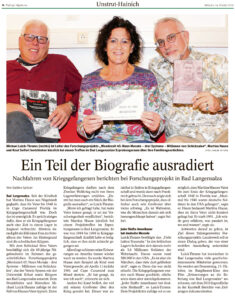
photo: Michael Luick-Thrams (right) is Chairman of the Research Project “Turning Point 45: nine months – three systems – millions of destinies”. Martina Hause and Knut Seifert narrated their families’ stories during a meeting held recently in Bad Langensalza.
Unstrut-Hainich
PART OF THE BIOGRAPHY WAS ERASED
Descendants of Prisoners of War reported for
a Research Project in Bad Langensalza
by Sabine Spitzer
Bad Langensalza. During all her childhood Martina Hause from Nägelstedt believed that her father had been in war captivity in Cape Canaveral Florida until 1948. But that is impossible. There is a lot of evidence that he had also spent some time as a prisoner of war in England. A clue to this is the picture of a woman in her father’s photo album. In the background, one can see the Scottish cliffs.
60-year-old Martina Hause engages herself with her father’s destiny in the context of the research project “Turning Point 45: nine months – three systems – millions of destinies” which is realized by the History Society “Spuren” together with the Erfurt University and citizens of Bad Langensalza. According to Michael Luick-Thrams, historian and Chairman of the Project, the case of Hause’s father is typical. Prisoners of war were not allowed to talk about their experiences in Prisoner Camps. “Thus also part of the biography was erased”, says Michael Luick-Thrams. “When I asked, my father always replied that he had been committed to secrecy,” says Martina Hause during a project meeting in Bad Langensalza. He was imprisoned from 1944 to 1948. The only thing he said was that they were not treated badly.
However, his memories of America seemed to return again and again. Thus, as an example, Martina Hause was awakened by her father in 1961 when Apollo 11 started to the moon in Cape Canaveral. And he continued: “I was also there”, she remembers.
Differently, Knut Seifert, who spoke a lot about the war with his grandfather, who had first been imprisoned in Italy and taken afterward to France. Nevertheless, the research project disclosed that also his grandfather had kept silent about many things. “It is plain folly what many people lugged around at those times,” says Seifert.
Every fifth American has German roots
Luick-Thrams confirms: “Many had psychic traumata.” At times there were more than 3.6 million soldiers of the German Armed Forces in British camps. Only about 380.000 had been in the United States. “However, it is a myth that many stayed there”, he says, “that was not allowed.” The prisoners were sent back home, but quite a lot returned afterward. “Every fifth American has German roots”, says Luick-Thrams. According to the Chairman of the Project, it is impossible that Martina Hause’s father stayed in Florida until the end of his imprisonment in 1948. German soldiers were imprisoned in the U.S at most until 1946 ”, he says. Martina Hause regrets that she didn’t ask her father precisely. He died in 1991. “I would like to know what happened, when, and where.”, she says.
To answer these questions is the goal of this research project in all of Thuringia. Nationwide there will be a dialogue, supported by a mobile exhibition.
In the meantime, Luick-Thrams has been able to win many fellow campaigners interested in history. On 15th October, they will meet in the Burgtheater Cinema to watch the movie “Memories of the Relief of Bad Langensalza”. In 2010, young persons collected reports of contemporary witnesses in the city.
Translated from German by Karin Schramm.
27 September 2020
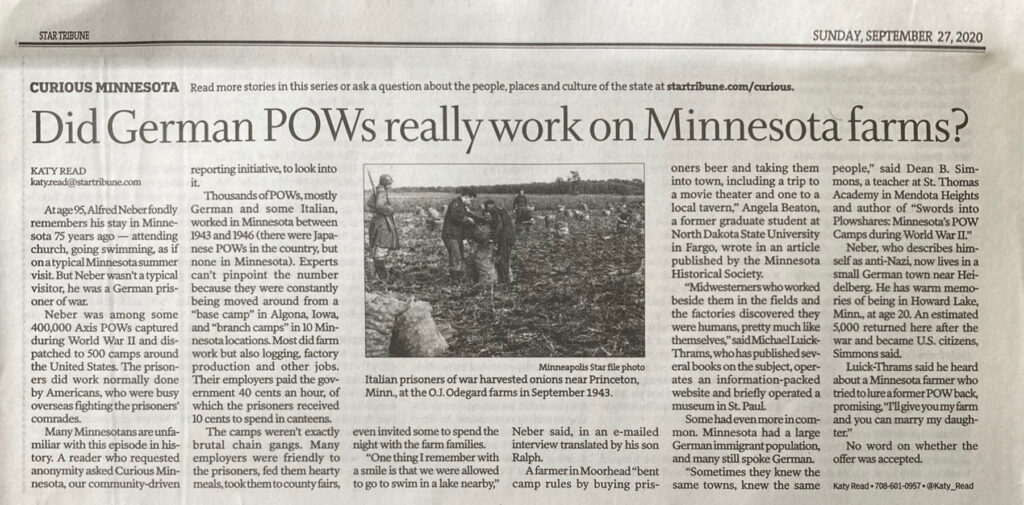
24 September 2020
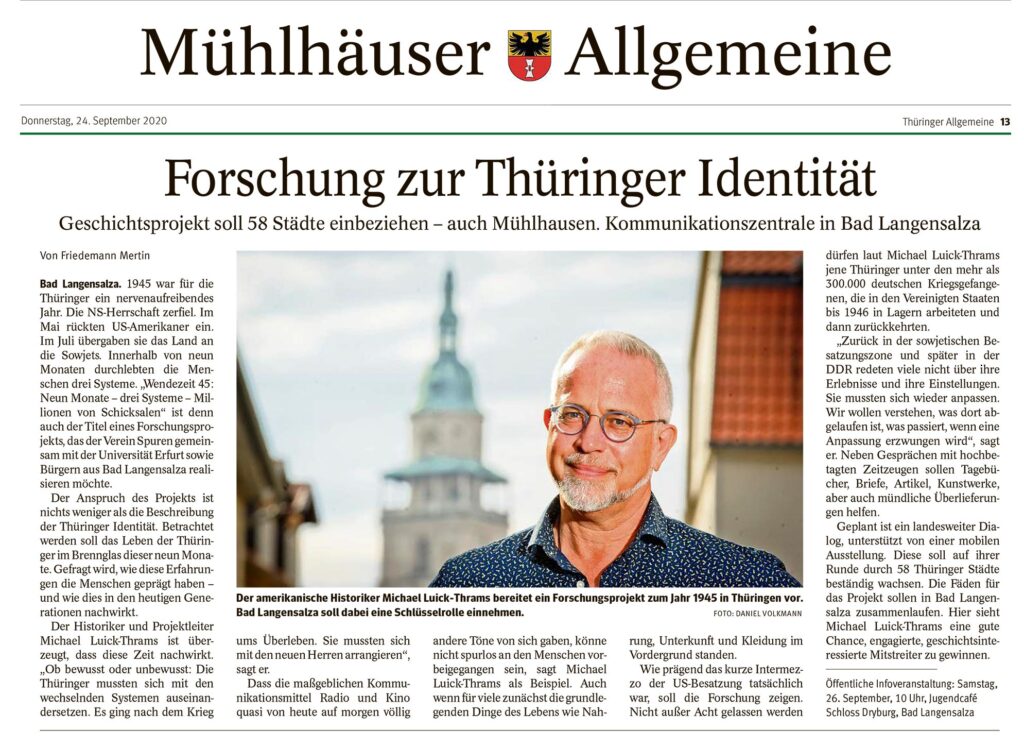
30 January 2020
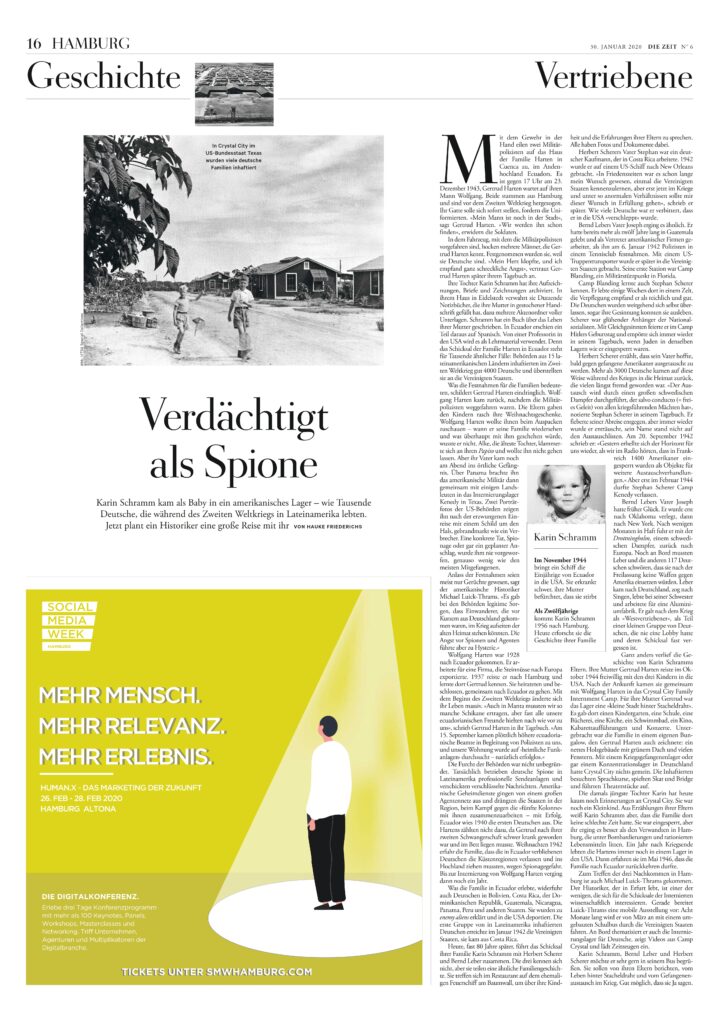
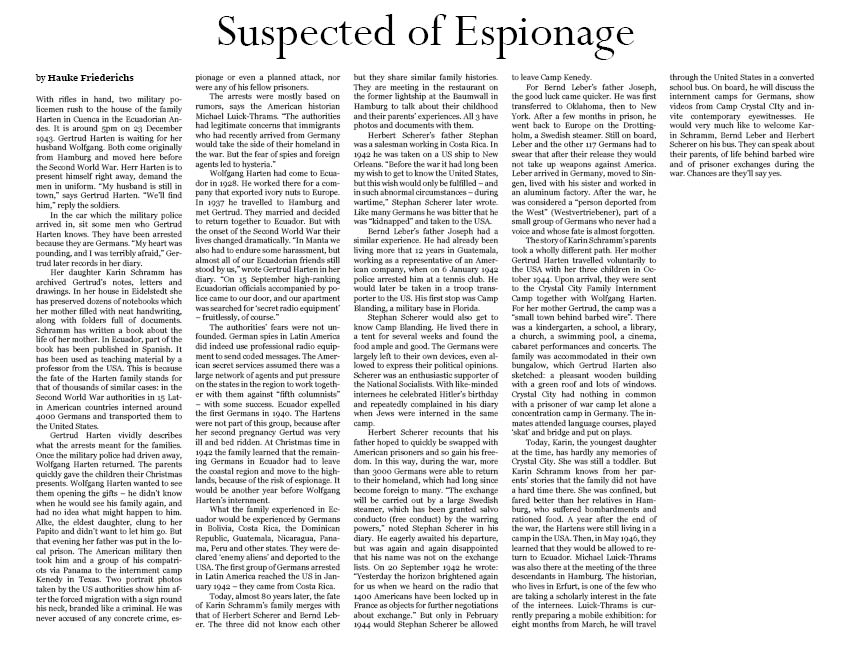
3 October 2019
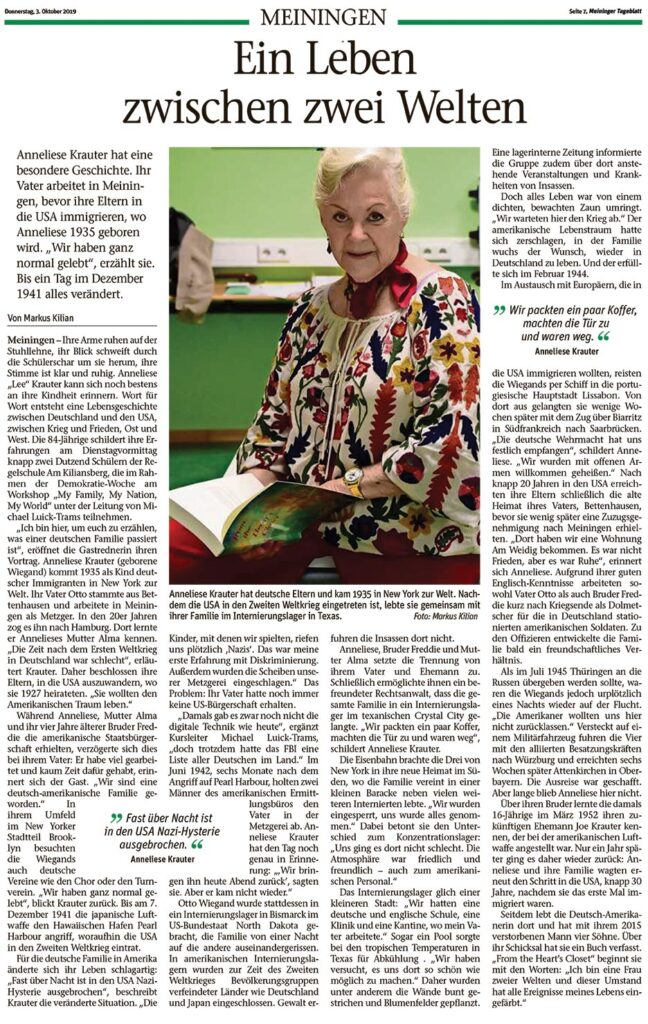
My Life between Two Worlds [translation of above German article]
Anneliese Krauter has a special story. Her father worked in Meiningen before her parents immigrated to the USA, where Anneliese was born in 1935. “We lived quite normally,” she says, until one day in December 1941 changed everything.
by Markus Kilian, Meiningen
Her arms rest on the back of her chair, her gaze sweeping around her through the crowd, her voice is clear and calm. Anneliese “Lee” Krauter can still remember her childhood. Word for word she creates a life story between Germany and the United States, between war and peace, between East and West. The 84-year-old describes her experiences to nearly two dozen students of the Regular school at Kiliansberg, which is participating in the “Week of Democracy” on Tuesday morning, the workshop “My Family, My Nation, My World” under the direction of Michael Luick-Thrams [Exec. Dir. of TRACESpuren]. “I’m here to tell you what happened to one German family.”
Anneliese Krauter (née Wiegand) was born in New York in 1935 as a child of German immigrants. Her father Otto came from Bettenhausen and worked in Meiningen as a butcher in the 1920s, then moved to Hamburg, where he met Anneliese’s mother Alma. “The years after World War I were bad” explains Krauter. Therefore, her parents decided to emigrate to the US, where they married in 1927. “They wanted to live the American Dream.”
While Anneliese, her mother Alma and her four-year-older brother Freddie received American citizenship, this was delayed for her father: He worked a lot and barely had time for it, recalls the guest. “We had become a German-American family.” In their environment, in a Brooklyn neighborhood, the Wiegands also frequented German clubs, such as the choir and the gymnastics club. Krauter looks back on a very normal way of life: Until 7 December 1941—when the Japanese air force attacked the Hawaiian harbor of Pearl Harbor, prompting the US to enter World War II—and her life changed abruptly for the German family in America: “Almost overnight, Nazi hysteria broke out in the US,” Krauter describes the changed situation. “The children we were playing with suddenly called us ‚Nazis’. This was my first experience of discrimination. In addition, the windows of our butchery were smashed.” A problem: Her father still had not received US citizenship.
“At that time there was still not the digital technology as today,” added course leader Michael Luick-Trams, “but still the FBI had a list of all Germans in the country.” In July 1942, six months after the Pearl Harbor attack, two men from the US Bureau of Investigation picked up the father at the butchers shop. Anneliese Krauter remembers the day exactly: “’We’ll bring him back tonight,’ they said, but he did not come back.” Otto Wiegand was instead taken to a detention center in Bismarck, North Dakota—and the family torn apart from one night to the next. American detention camps included populations of Axis countries such as Germany and Japan during the Second World War. The inmates were not subjected to violence there.
For Anneliese, brother Freddie and mother Alma, the separation from their father and husband was difficult. Finally, a befriended lawyer made it possible for the entire family to move a detention center in Crystal City, Texas. “We packed a few suitcases, closed the door and were gone.” The railway brought the three from New York to their new home in the south, where the family lived together in a small barracks alongside many other internees. “We were locked up, everything was taken from us.” She emphasizes the difference to the concentration camp: “We didn’t have a bad life there, the atmosphere was peaceful and friendly—even to the American staff.”
The detention center resembled a small city: “We had a German and an English school, a clinic, and a canteen where my dad worked.” Even a pool to cool off from the tropical temperatures in Texas. “We tried to make it as nice as possible there. Therefore, among other things, the walls were painted colorful and flower fields planted.” A newspaper in the detention camp informed inmates of up-coming events or diseases of other inmates.
However, their life was surrounded by a tight and guarded fence. “We waited for the war to end.” The American dream had burst, and the family’s wish of return to Germany had grown stronger and was eventually fulfilled in February 1944.
In exchange for Europeans wanting to repatriate to the USA, the Wiegand family travelled by ship to the Portuguese port city of Lisbon. From there, within a few weeks, they reached Saarbrücken via Biarritz by train. “The German army received us solemnly” describes Anneliese. “We were welcomed with open arms.” After 20 years in the USA, the family returned to the father’s old home town, Bettenhausen, before being permitted to move to Meiningen. “There we got an apartment ‘Am Weidig;’ the war wasn’t over yet, but we had found peace.” remembers Anneliese. Because of their good English language skills both the father and the older brother Freddie worked as interpreters for the US-troops stationed in Germany after the war had finally ended. The family developed a friendly relationship with the Army officers.
When in July 1945 Thuringia was to be handed over to the Russians, the Wiegand family once again had to flee. “The Americans didn’t want to leave us behind.” Hidden on a military transport, the four travelled with the Allied forces to Würzburg and arrived six weeks later in Attenkirchen, in Upper Bavaria. The escape was successful, but Anneliese didn’t stay long in Attenkirchen.
Through her brother, the then-17-year-old Anneliese met in March 1952 her future husband Joe Krauter, who had worked for the American Airforce. A year later Anneliese and her family again returned to the USA, almost 30 years after emigrating there the first time.
Since then the German-American lives there and has four sons; her husband died in 2015. She wrote a book about her fateful life. “From the Heart’s Closet” starts with the words “I am a woman of two worlds and this has affected all circumstances of my life.”
Press release:
It was wartime on the US home front. She was an American—wasn’t she? Anneliese had been born in New York, of German-immigrant parents (one already naturalized, one awaiting that). As citizens, the eight-year-old girl, her older brother Freddie and her Waldorf-hotel salad-chef mother “should” have been guaranteed due process when “Lee’s” father was interned as a suspected traitor—but they were not. Instead, they “voluntarily” took residence at Camp Crystal City, until they, too, were “repatriated” and forcibly sent to Europe, where the family was traded for Axis-held US nationals… and then the Wiegands’ adventure really started!

caption written by Anneliese (left): “Xmas 1942 family pic we sent to Pappi
while he was in internment camp” near Bismarck, North Dakota; the
photo shows Anneliese, mother Alma (née Wiedrich) and brother Freddy
At the end of September and beginning of October 2019, Lee will visit Meiningen to speak at a school, as well as visit her old “stamping grounds” where her deported family found a home. Sponsored by Spuren e.V. (www.TRACES.org), she welcomes an interviews: 0049.176.34 38 70 65 or contact her directly at annelie235@aol.com.
About the speaker:
Anneliese “Lee” [Wiegand] Krauter
was born to a German immigrant family in New York. During World War II, her
family was detained in the civilian internment camp at Crystal City, Texas: A
short US government 1945-46 color film about the camp is at:
https://www.youtube.com/watch?v=WRfSHgdh2UA&feature=youtu.be


left: Anneliese „Lee” [Wiegand] Krauter; Director of Spuren e.V., Michael Luick-Thrams with Anneliese after his lecture at the Indiana Historical Center, Indianapolis/USA, 16 October 2018
They were “repatriated” and sent to the Third Reich, where the family found a haven in her father’s hometown, Meiningen. Just in front of the Red Army, they fled to Bavaria, where she met her future husband, Joe Krauter, a soldier with the occupying American forces. They married, then went to his native Indiana, where Lee still lives.
An honor student in both American
and German schools, Lee attended the High School of Music & Art in New York
City and earned a Certificate in Business from the Private Handelsschule Sabel
in Munich, Germany, later taking courses in creative writing and journalism at
Indiana University, Purdue University, Indianapolis.
After one of her sons was diagnosed with juvenile diabetes, she spent years
volunteering with the American Diabetes Association, serving in both local and
national positions. She earned many awards in the Association and was named
National Outstanding Affiliate Volunteer of the Year in 1990. She was also
appointed to the National Institutes of Health in Washington, D.C., for service
on the National Diabetes Advisory Board. She functioned as a lay person
representing the diabetes community, speaking on behalf of families living with
Type I (Juvenile) Diabetes.
Lee has spoken about her life as a child in America and Germany to many school
and adult audiences and has been a volunteer educator on living with diabetes
in schools in Indiana. Her book, “From the Heart’s Closet: A Young Girl’s
World War II Story,” describes in detail her life in two countries, during
both wartime and peace time. See: http://www.theschatzipress.com/ and https://www.thestoryoftexas.com/discover/texas-story-project/nicole-johnson-crystal-city

original subtitle: “Historical photo of German-American children interned at Crystal City”
—
3 March 2016
to view larger version, click on icon of above article
to view larger version, click on icon of above article
10 August 2013
May 2012
to view larger version, click on icon of above article
27 September 2002
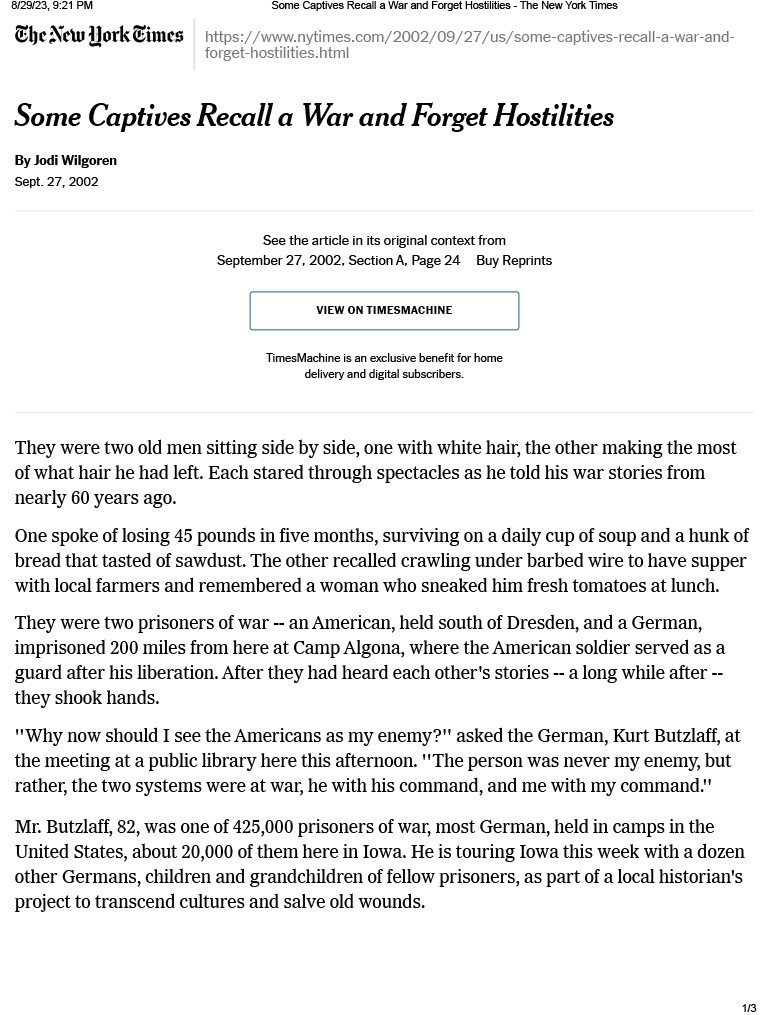
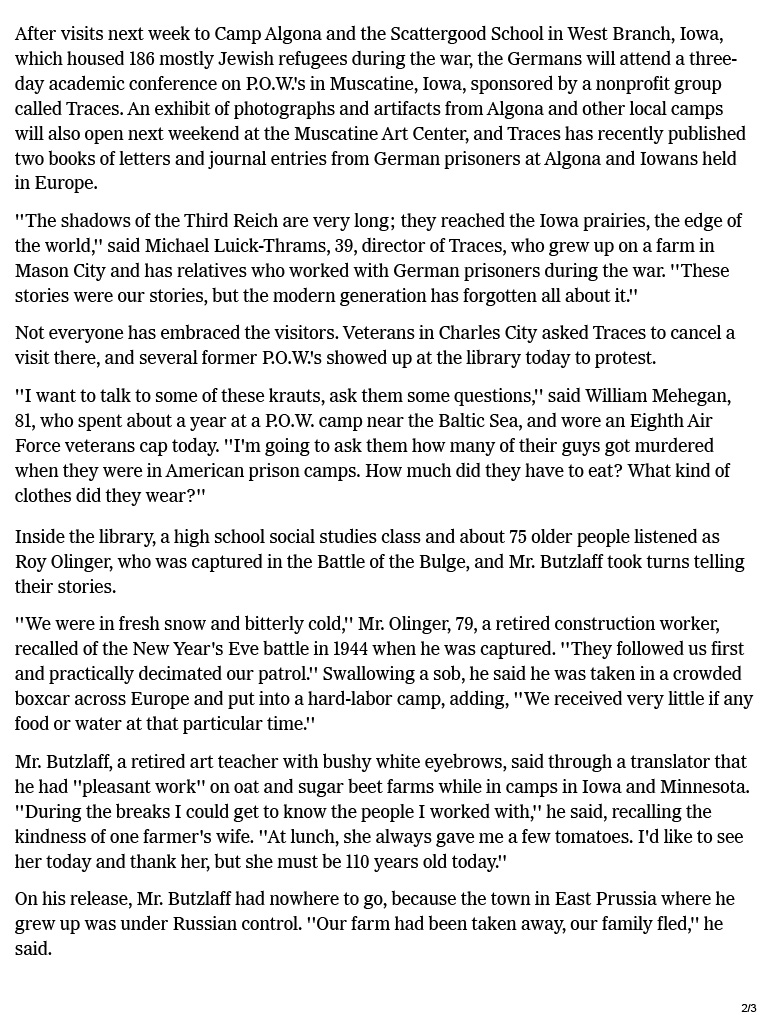

See the article in its original context from 27 September 2002, Section A, Page 24 on Timesmachine
10 October 2001
